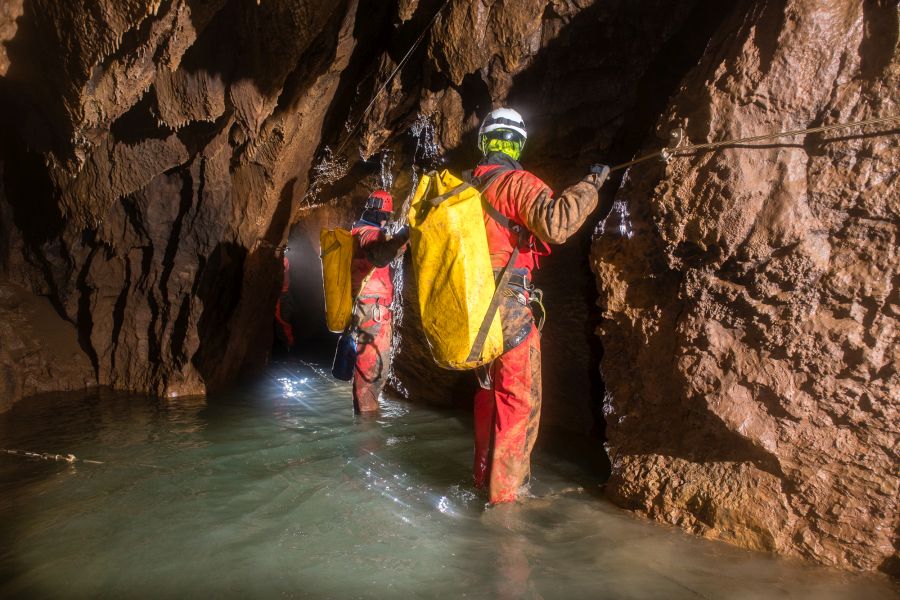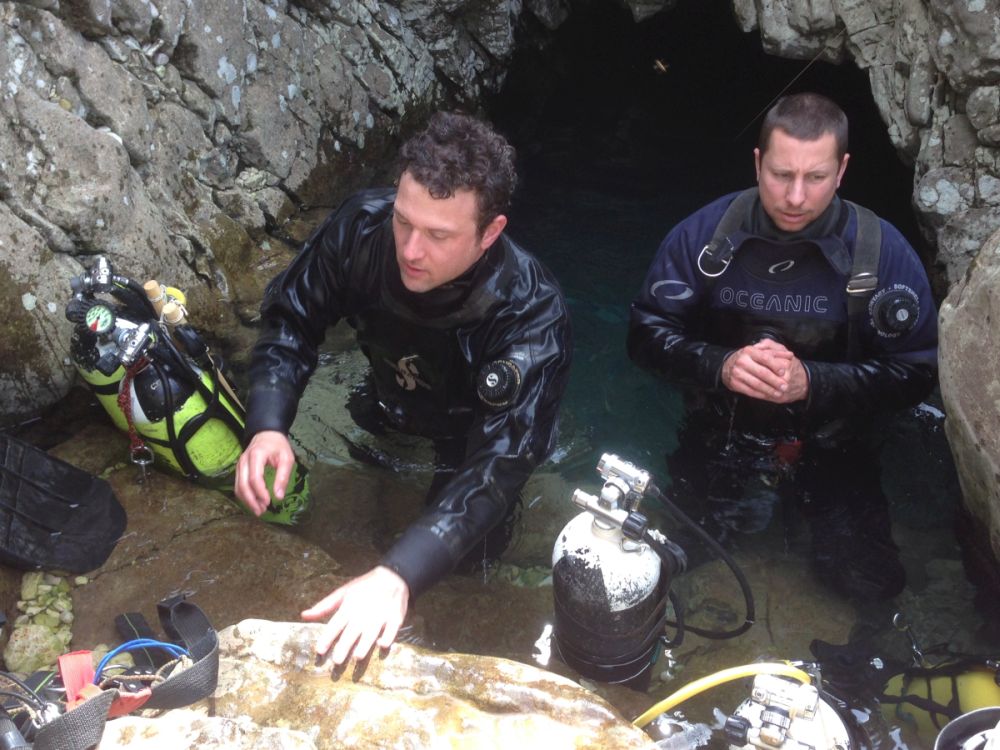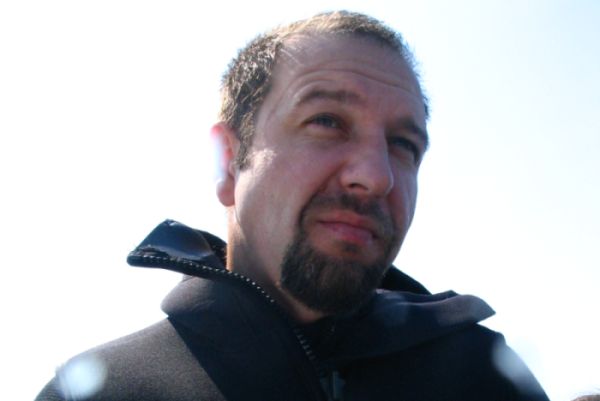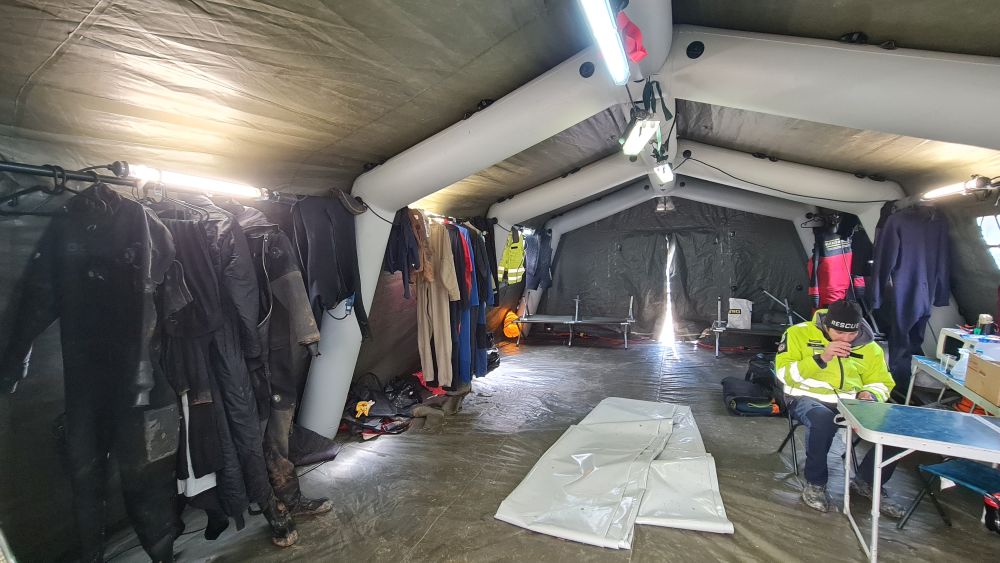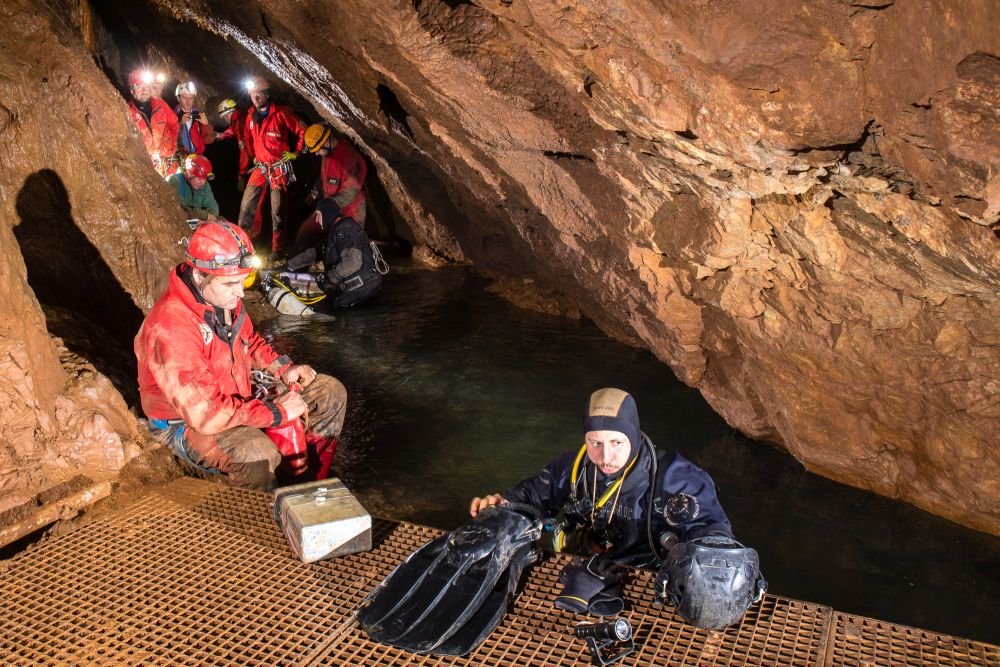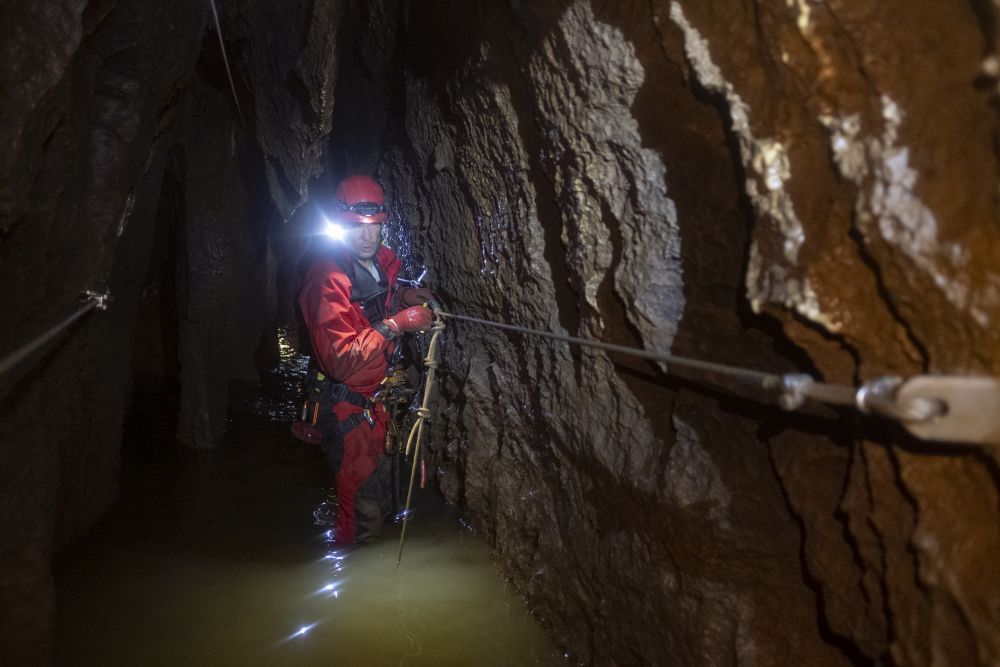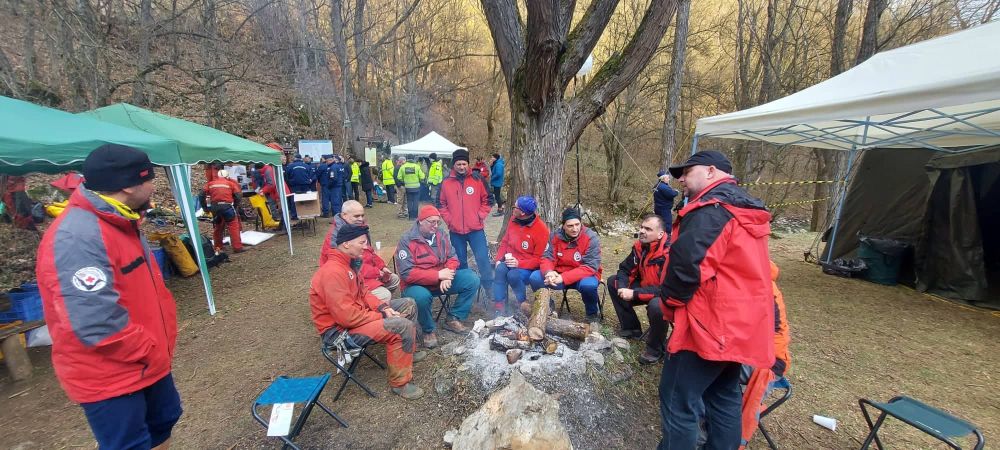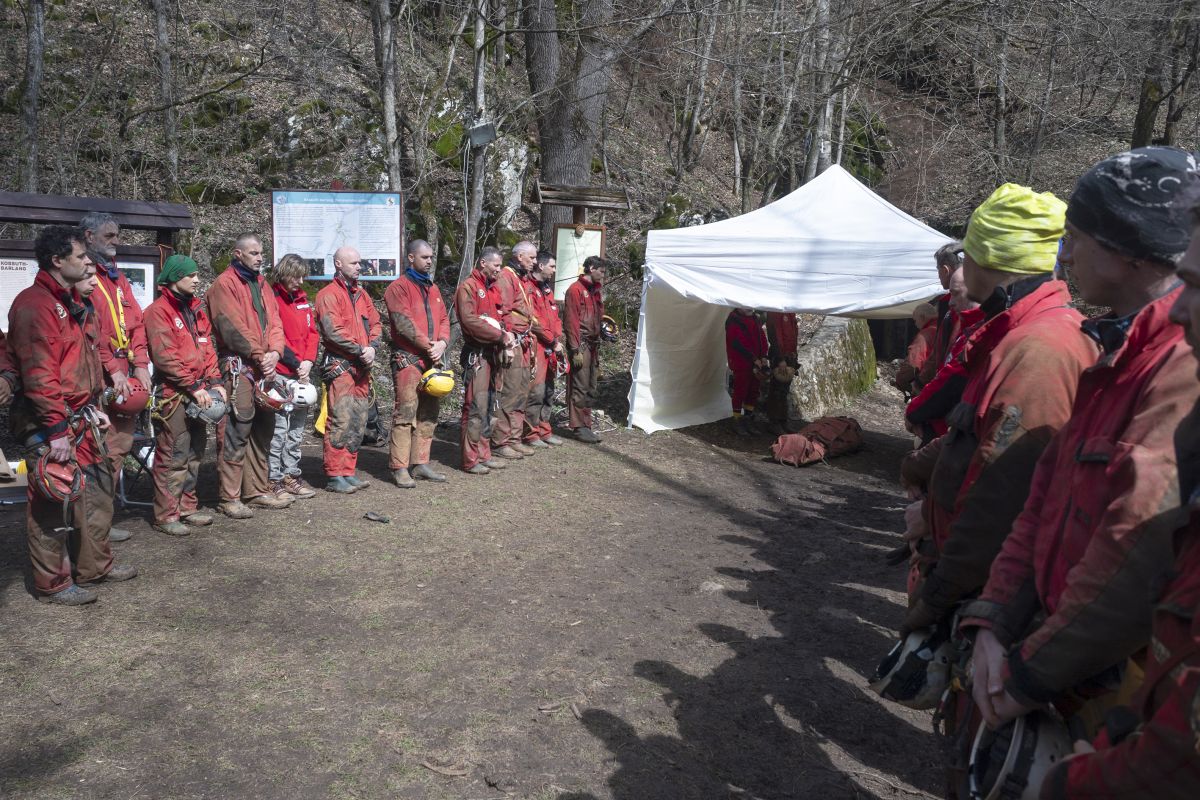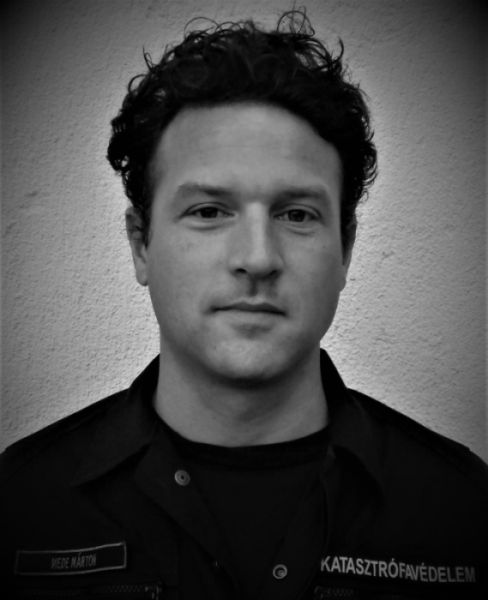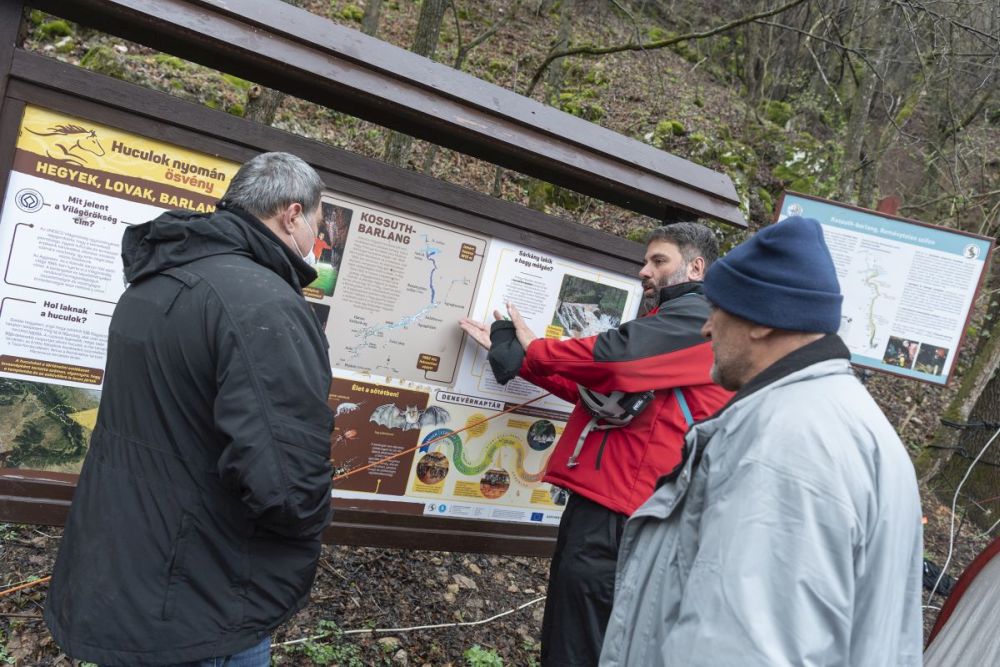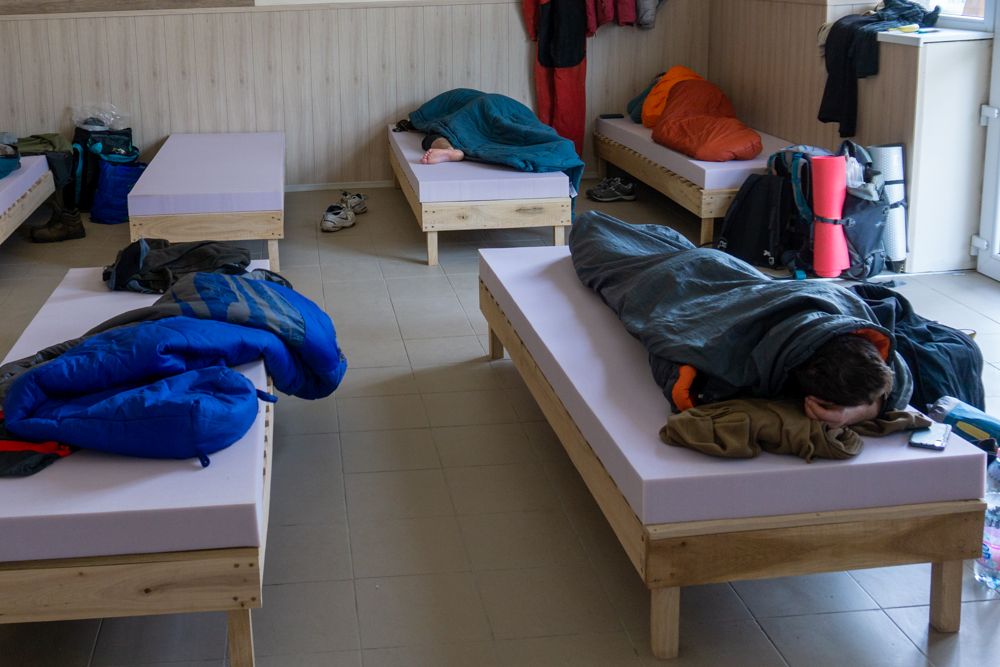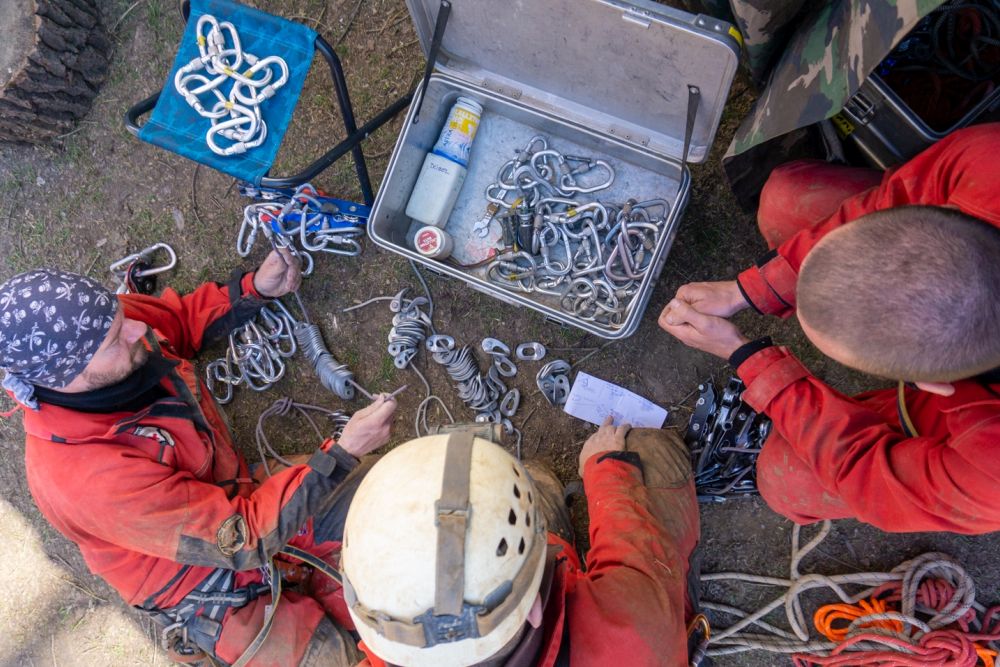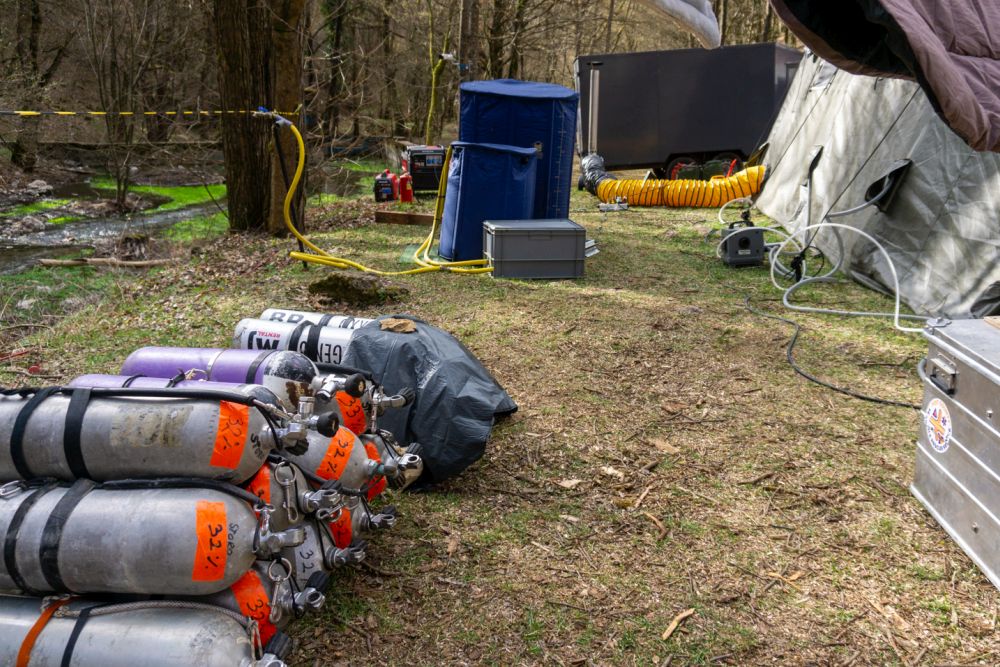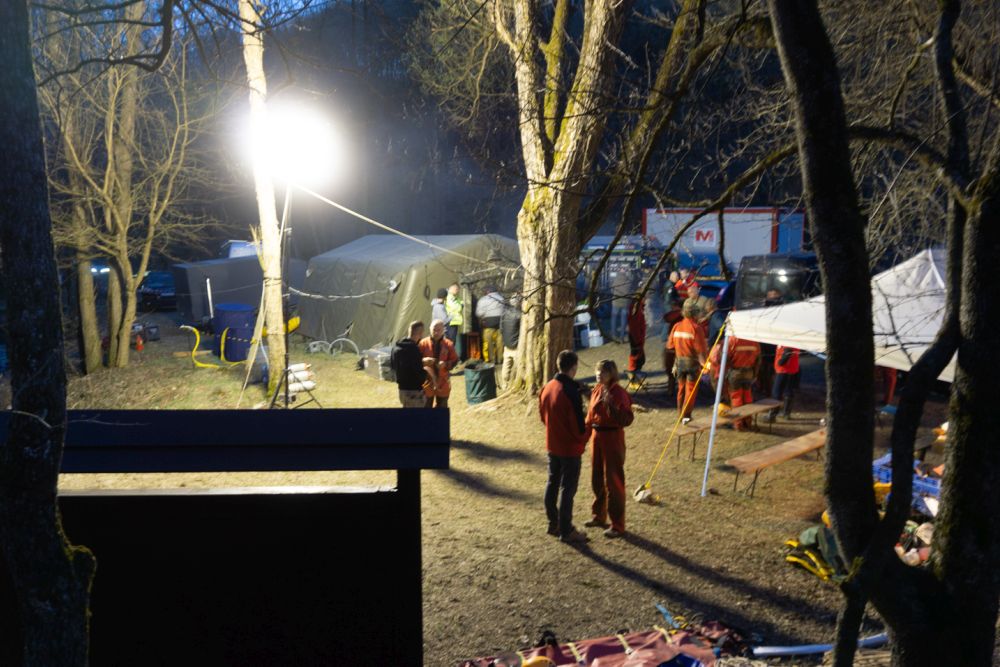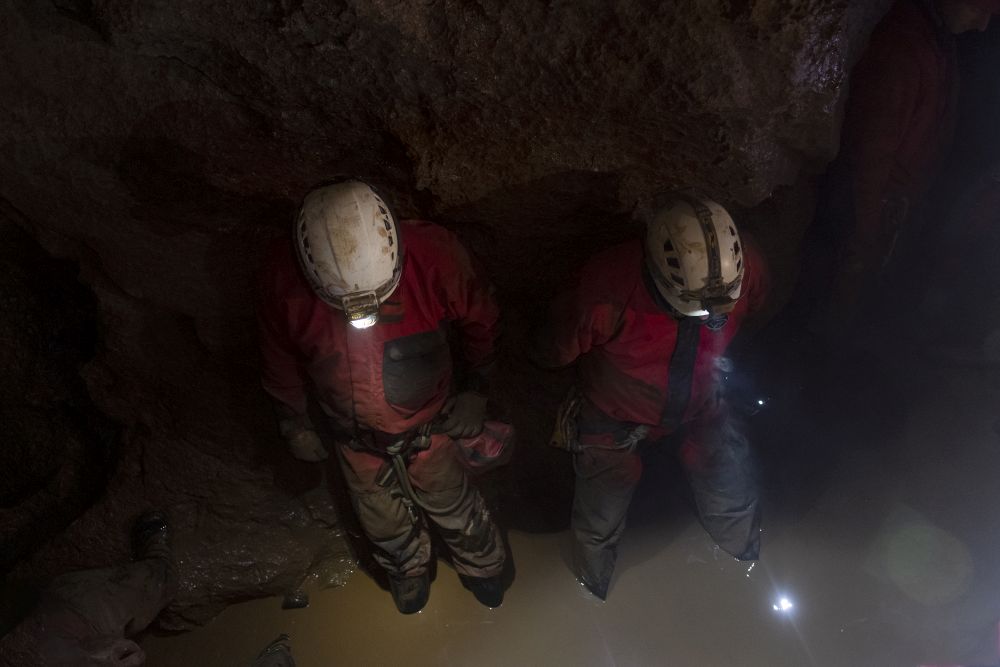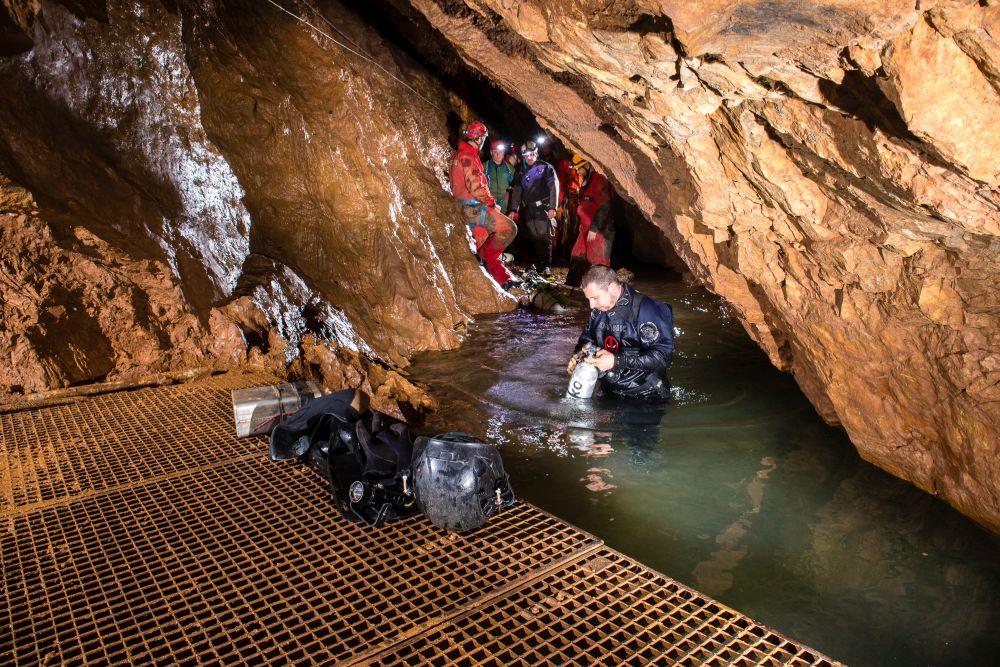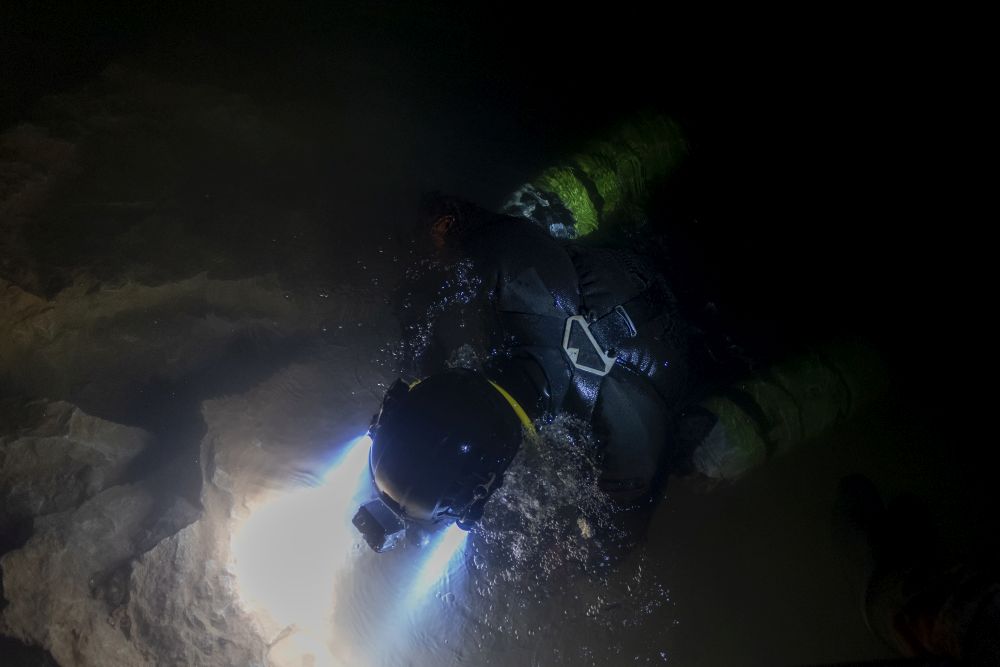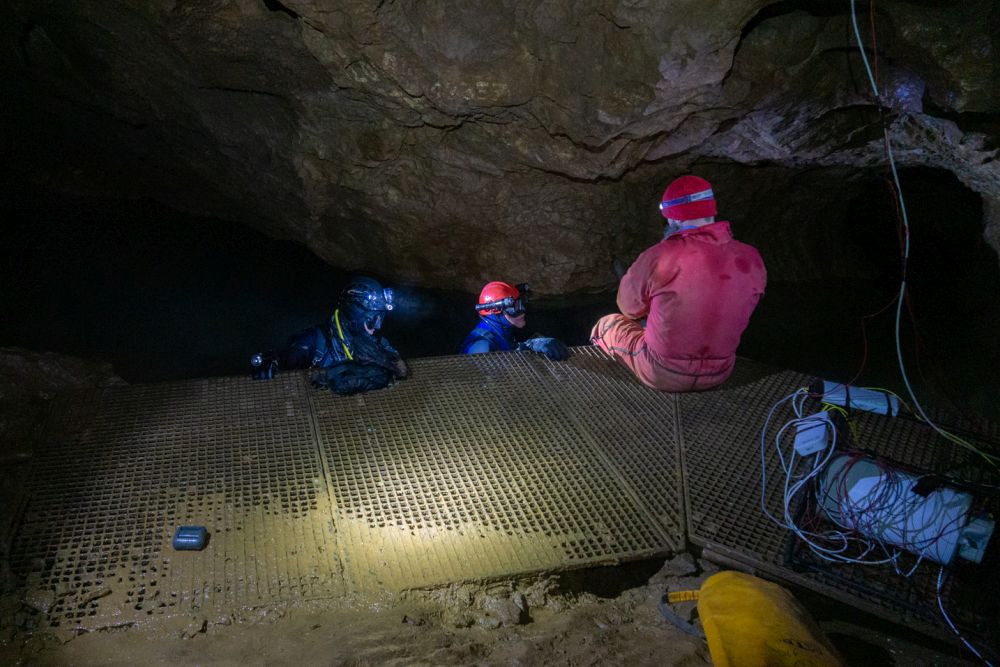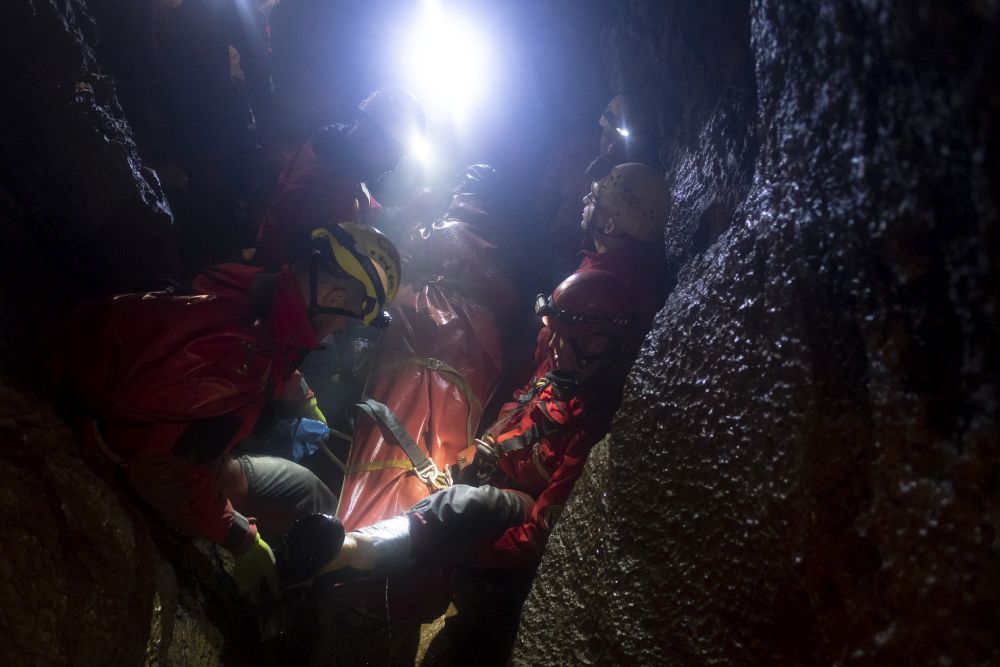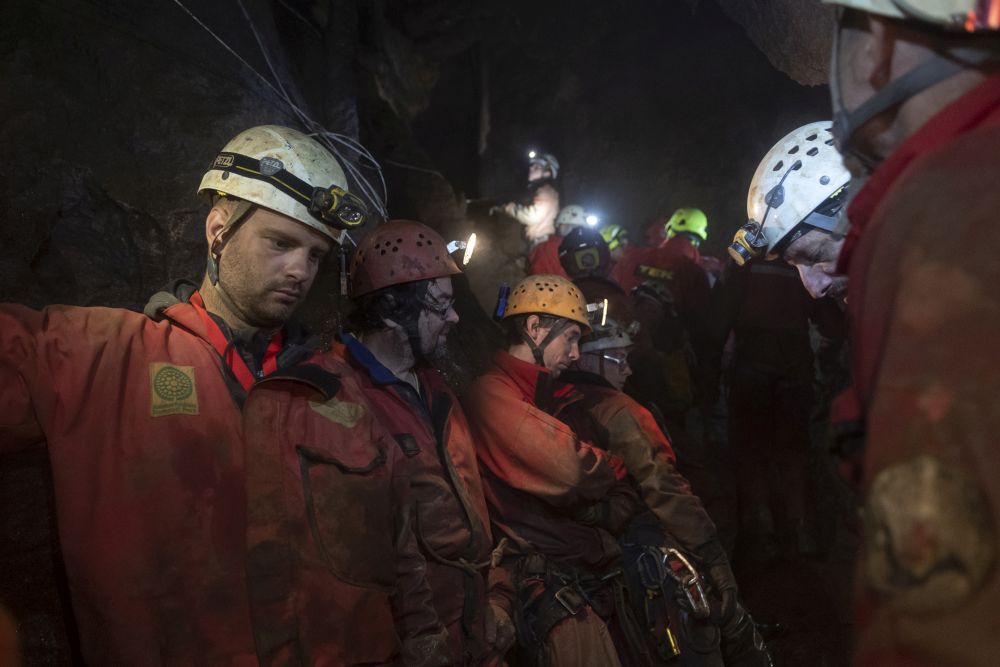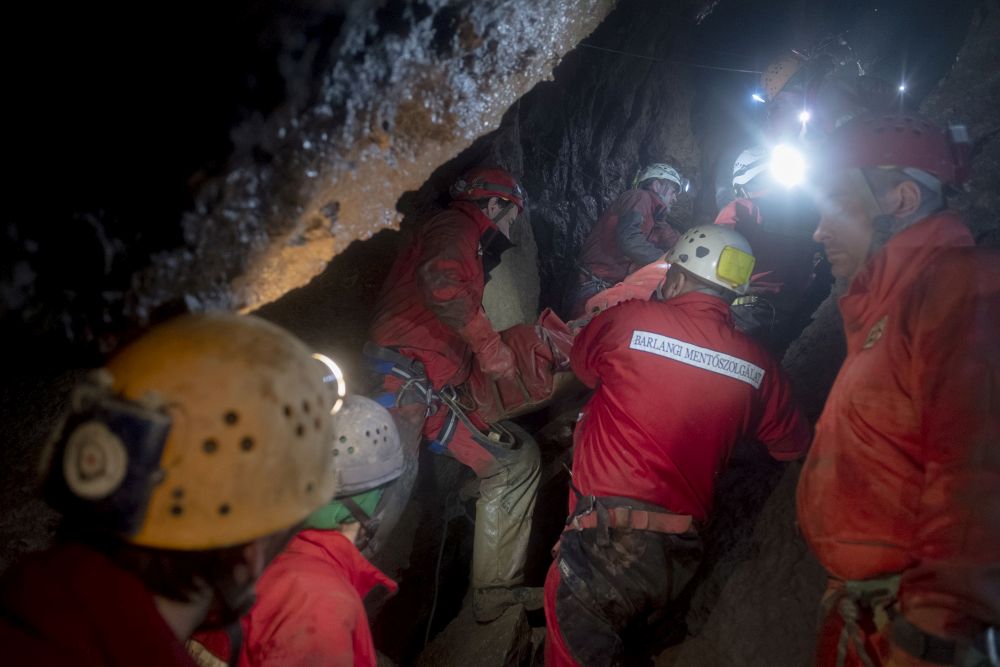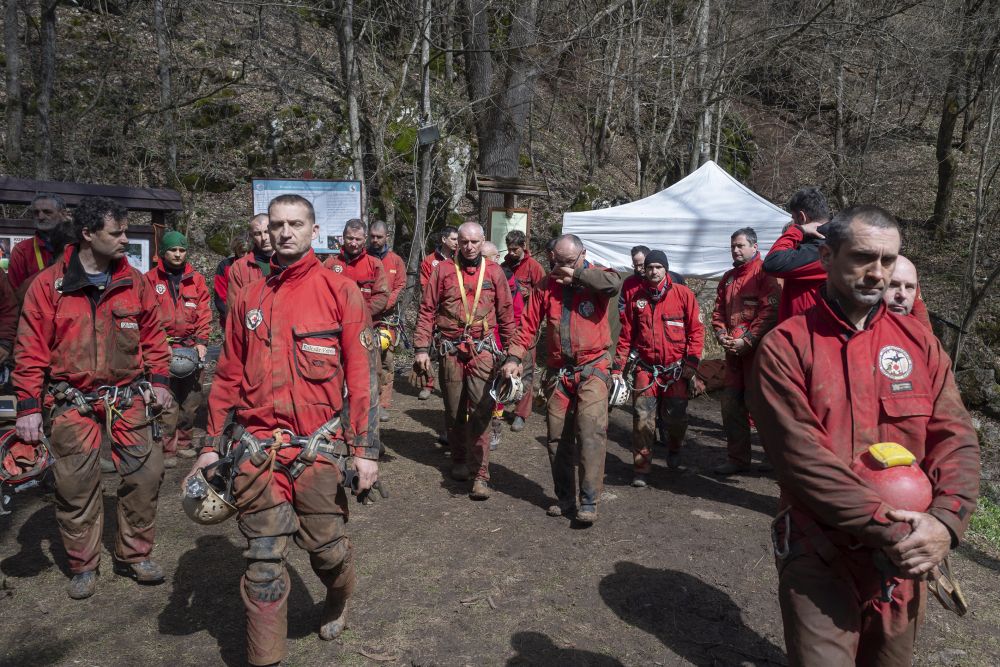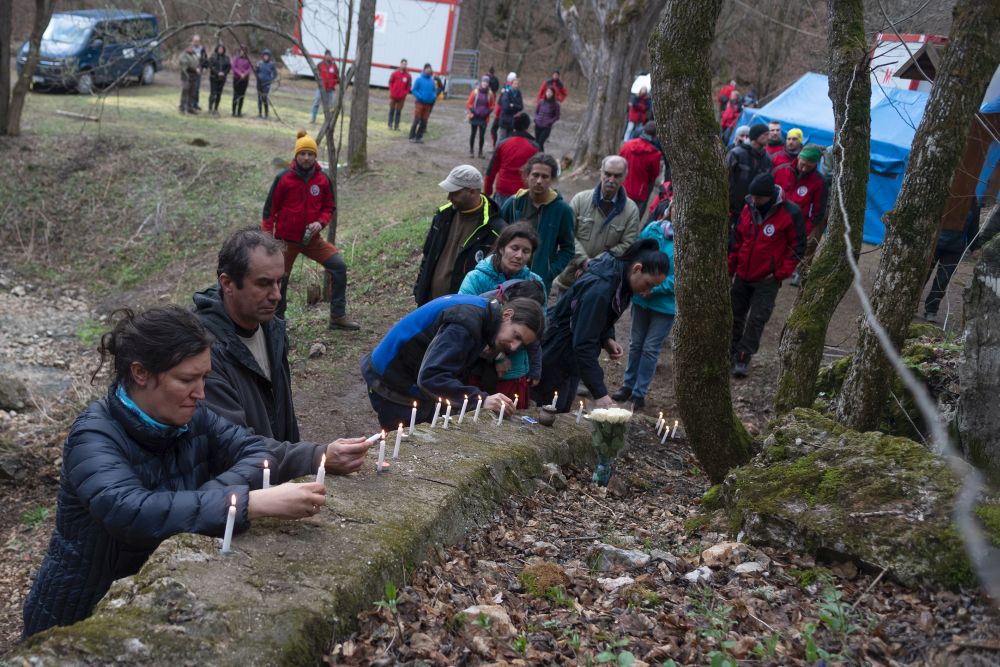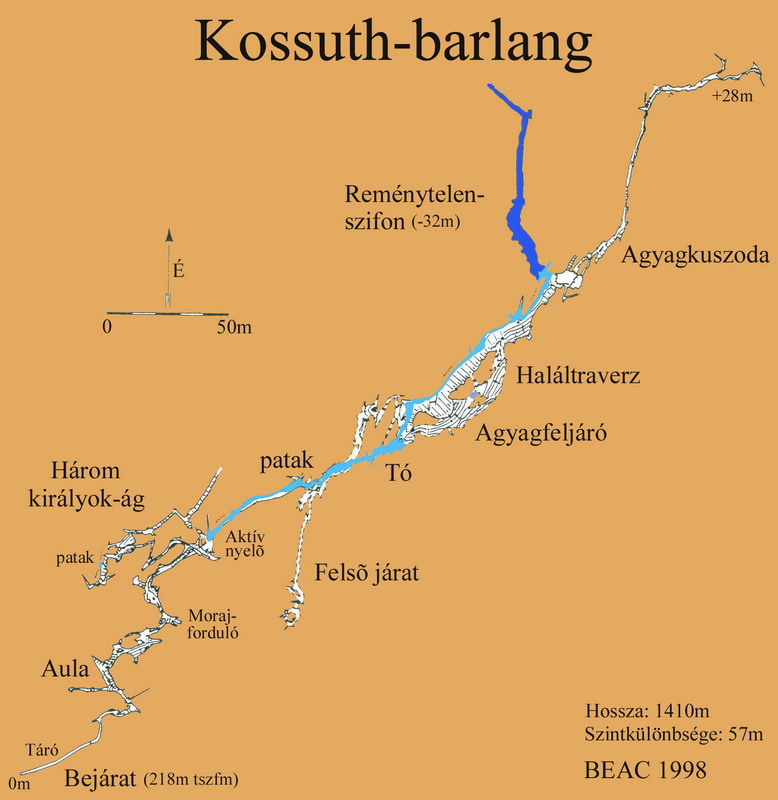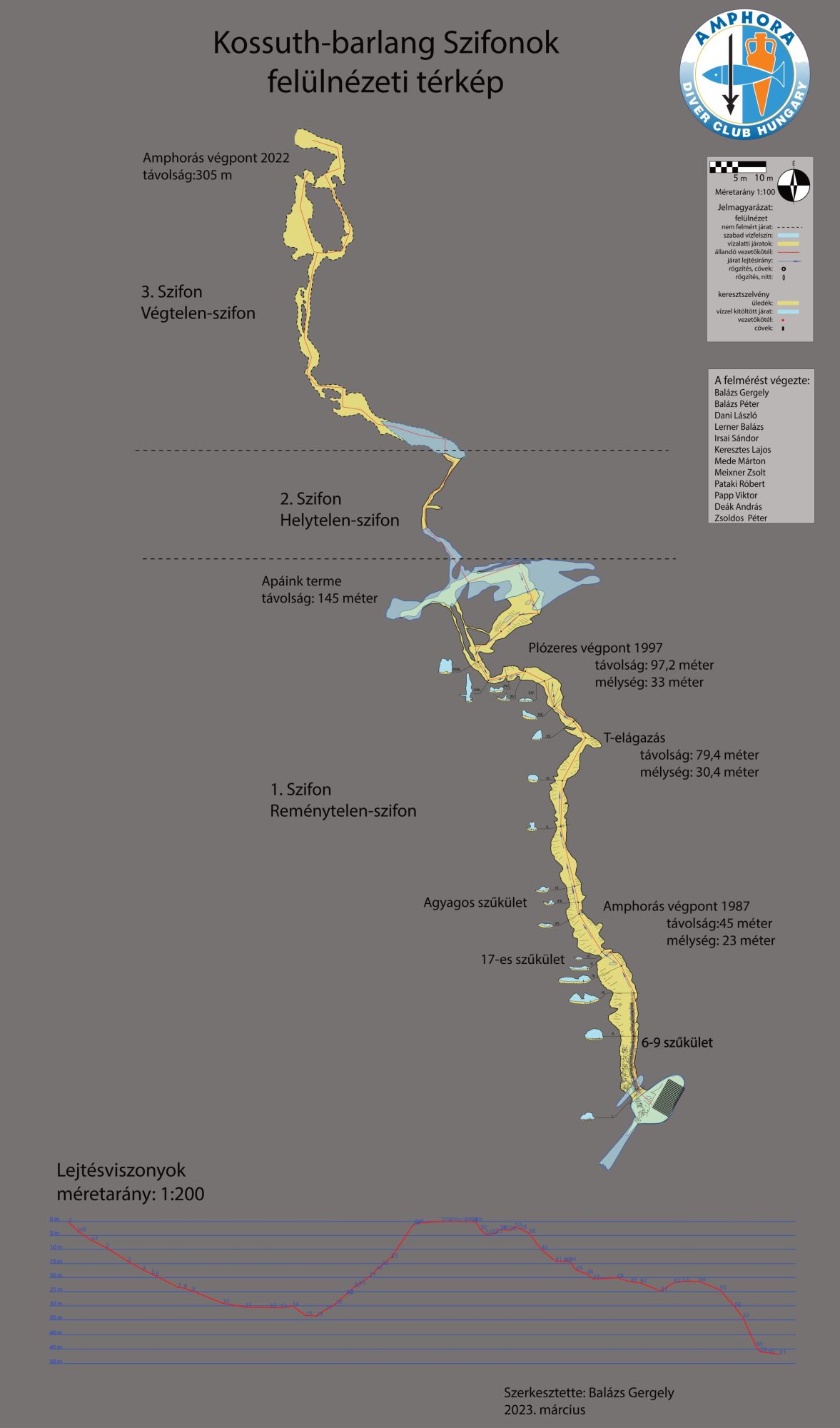On April 3, 2022, Márton Mede has not returned from the end of his cave exploration work at the endpoint at Siphon three of the Kossuth Cave in Jósvafő, Hungary at a depth of -48 meters. His disappearance marked the beginning of Hungary's longest-ever week-long complex diving and cave rescue operation, which unfortunately only managed to bring the diver's body to the surface. As far as we know, at the moment, the tragedy was caused by an underwater collapse, during which the diver died immediately or very quickly. During the week of the rescue, a total of 20 organisations and more than 250 people were involved in the operation. The underwater part of the rescue was carried out by the Amphora diving club, the dry part of the cave was managed by the Hungarian Cave Rescue Service, the Association of Cave Rescuers of Northern Hungary, the Bakony Cave Rescue Service and the cave rescuers of Speleo Roznava, the surface management and logistics were carried out by the Pest County Search and Rescue Service, the Counter-Terrorism Centre, the Civil Protection, the Aggtelek National Park Directorate (ANPI) and the Municipality of Jósvafő. Several other organisations also provided assistance on the spot, which are reported in the article.
The author of this article is András Hegedűs (Juju), Head of training and development, Rescue Operation Leader at the Hungarian Cave Rescue Service. The detailed summary is published one year after the rescue.
Day one - we have a problem...
Sunday, early afternoon. I'm at work. Ricsi (Richárd Horváth, head of the Hungarian Cave Rescue Service - BMSz) calls me on the phone: the lead diver in Kossuth cave hasn’t come up at the given time, then the backup diver went searching after him... Who is it, do we know?...
No, that's all what Gergő Balázs (Amphora diver) told me..... Let's put out a standby alert and I'll call Gergő back, what he’ll say about what the backup diver saw, fingers crossed...
I have a bad feeling. I'm at my workplace, starting packing in case I have to go to be ready in a moment’s notice. Soon the news arrives: the backup diver hasn’t found Marci... Our friend Marci Mede dived at the endpoint, but hasn't come back since. The news is devastating, and anyone who is familiar with the circumstances knows that the chance of him being alive is less than one percent or even less then one per million. But no! He must be alive, because a similar diving accident in Esztramos cave twenty years ago ended luckily! Marci is alive, he has crossed over to the other side of the underwater section and is waiting for us in an airy section/air-filled part! We must go immediately and organise a rescue! I call Ricsi back, we issue the high alert to every member of the BMSz, the Association of Cave Rescuers of Northern Hungary (BMÉE) and the Bakony Cave Rescue Service (BBMSz). Everyone will be needed in this case. We’re on the way…
I rush to get the equipment, my mind is spinning... Marci, just a few weeks ago we were hiking with your partner in life Kata (Lukács Kata) and the child of you two Lukács... Kata, my God, has someone notified Kata???? I'll call Gergő to ask if they've spoken to Kata. In the meantime, the high alert has gone out, more than a hundred cave rescuers know about it and are getting ready. No, no, Kata hasn't been called/notified yet... "Can you please tell her Juju, so she doesn't find out from someone else?" asked Gergő. "Of course" , not knowing then that I was about to have the most difficult phone conversation of my life. I took the phone into my hand and was unable to call her for a few minutes. "Kata, we are in big trouble, Marci didn't come out of the siphon on time and the backup diver couldn't find him". Kata is crying, I tell her to stay at home we will go get her, she shouldn’t go anywhere alone. I call my wife, Kacci (Katalin Hegedűs-Csondor) to pack her things, she and Alíz (our half year old child) come with me, and tell Zsófi (Zsófi Tarczi, wife of cave rescuer Viktor Izápy) to come with Vilma (their one and a half year old child) to keep Kata's spirits up during the rescue. As soon as we arrived at Kata's place, she was waiting at the gate with tears in her eyes and Lukács in her hands, we set off for the Kossuth cave.
The Kossuth Cave is located in the Aggtelek National Park, on the outskirts of the village of Jósvafő (Cave maps are below on the end of the article). It is a highly protected spring cave, its water feeds the Nagy-Tohonya spring. It was discovered in 1956, when researchers led by Hubert Kessler reached the entrance of the so-called "dry" section of the cave, the so-called "Hopeless" siphon (Reménytelen szifon), from where the passage continues under water. The water comes from the siphon and flows down the dry section of the cave towards the entrance, forming a cave stream at the bottom of the passage, in one part forming a lake. In dry weather, this section of the cave can be walked dry shod to the siphon, with the traversing of the passage being assisted in many places by walk-on wires stretched over the water, and in others by grabbable wires and ladders. The currently known length of the cave is nearly 1,500 meters and extends 52 meters vertically. Above the main part of the cave there is a dilapidated upper branch decorated with stalactites. The endpoint of the cave was for a long time the “Hopeless” Siphon, which was not passed until the early 2000s, even after numerous attempts. Unfortunately, this underwater section of the cave claimed a human life in 1997, when Zoltán Kominka, a research diver, died in the “Hopeless” Siphon. The search was made harder by the narrow, clayey, rubble-silt covered passage. The Amphora diving club set about the "hopeless" exploration with a systematic, well-prepared, step-by-step approach: years of work to excavate the underwater passage, widen the narrow passages and install a well-secured safety rope to guide the divers along the siphon (the first diver stirs up the clay, and then visibility drops to zero, and only using the guide rope can anyone safely return to the surface to reach the entrance of the siphon). Success was made in 2009: the Amphora team members made it through the “Hopeless” siphon and into the “Our Fathers’” hall ( Fathers’ hall, Apáink terme). But getting further was not easy, the walls of the airy chamber surround a lake, there is no dry land, and at the far end the passage continues underwater again, this time the bitterly narrow passage of siphon nr. two. This underwater section is not long, leading into a small airy fissure from which siphon three begins. The last point of the 'three' known to man is about 130 meters from the last airy section, at a depth of 48 meters, 305 meters from the start of the underwater section, where the accident occurred...
We are heading towards Jósvafő, I keep making calls, organising the rescue. The Gömör-Torna Regional Unit of the BMSz is on the spot, led by Péter Gruber, who is the deputy director of the Aggtelek National Park Directorate (ANPI). He is an old caver and cave rescuer, formerly a cave supervisor at the national park, and knows the cave very well. Peter explains that he contacted and requested assistance from the disaster management (Ministry of Interior National Directorate for Disaster Management - OKF) and the police to set up the surface infrastructure and support for the rescue operations. Cave rescuers Zoltán Kiss (Pucu) and Viktor Izápy arrived on the scene with rescue equipment and started to set up the surface management point. The first members of the Cave Rescue Association of Northern Hungary (BMÉE - Miskolc) also arrived. It is late in the evening and the telephone installation is starting (wireless radio equipment doesn’t work in the cave, after the first curve there is no signal, so a wire-phone is needed for communication). The telephone in the cave is already working before 11 pm. Preparations are underway for the next dive: carrying full tanks and equipment to the siphon in the dry parts, helping the divers prepare for the dive, organising a medical team of cave rescue doctors to be on duty at the siphon. The first to descend into the cave is Dr. Judit Tóth, a medical doctor (MD) from our regional unit. Twenty cave rescuers are already working in the depths. Near the entrance, the Pest County Search and Rescue Service (PMKMSZ) builds a heated tent, spotlights, generators and compressors for filling the diving tanks (the compressors were later charged in the Curia in Jósvafő, because the high power consumption could only be safely met there). The service, although "Pest County", was led by László Balázs, brother of the Amphora diver Gergő Balázs, and a childhood friend of Marci Mede, who immediately went to the scene with his men to help. Right next to the entrance, a table is placed under a tiny pavilion without sides, where the cave telephone surface station, surface telephones, radios, computer, traditional paper records are located: the rescue's management point.
Image 1: rescue's management point. Modor, Viktor, Pucu, Juju, Péter Gruber discussing (Photo: Géza Bräutigam)
It's after midnight, snowing with minus four degrees outside. Warm coffee and tea are our lifesavers. Viktor Pap and András Deák prepare to dive. Viktor's dry suit is damaged, we are trying to arrange for another one, we still need magnesium, we will send it in later. Viktor puts on Laci Dani's dry suit, they prepare for a 90 minutes long dive. The phone is also set up underwater to the Fathers’ Hall, from there the divers check in from all directions. In the Fathers’ Hall there is an artificially built diving base, the "trepni" (batten/floorboard), where equipment can be unloaded, sorted and stored. The telephone unit is also located here.
I switch places with Viktor Izápy at the management point so he can warm up a little. It's two o'clock in the morning, the divers return from the siphon, and we receive brief information on the phone: the underwater passage is blocked... On the surface they explain it thoroughly: „the diver found the endpoint collapsed, the 8 mm diameter safety guide rope is embedded in the mud, the passage has completely collapsed." Everyone is now on the surface, the phone is off, there is only deep silence. Divers leave for a couple of hours to recover and resume tomorrow (sorry, today, Monday) at 11 am, they will try make a video of the collapse to see what can be done with it. The cave rescuers will stay, organize, and prepare everything for the morning. It will be a long rescue, we need food and shelter... Péter Adamkó finally reached Mayor Gábor Jóna, who immediately helped with accommodation.
I'm getting deep in my thoughts... Marci dived with two cylinders/scuba tanks, the rule of thumb is that you use third of your total air supply for entering, an other third for egress and one third is for reserve, the amounts he can monitor on his instruments all the time. It's been 12 hours since he set off, there is no chance of him being alive underwater, he ran out of air a long time ago. And Marci is not reckless, he is one of the best cave divers in the country.
Márton Mede, also known as Marci or Gúnár („Gander”), is 42 years old and one of the best divers in Hungary. As a navigational scuba diver he is a multiple Hungarian champion, a silver and bronze medalist at the European Championships and has won several medals at world competitions. He was also an experienced caver in dry areas, a driving force in underwater cave exploration, and an active member of national and international research. After graduating from the University of Physical Education in 2008, diving became not only a leisure activity in his life, but also his full-time job: he worked for the diving service of the Budapest Directorate for Disaster Management. During the "Hableány" accident, the ship collision disaster of 2019 in Budapest, he performed outstanding underwater work even on an international level, for which he received a state award. During underwater cave explorations in Bosnia, Montenegro and Hungary, he has advanced step by step with the utmost safety. We often talked about the subject, asking him: 'Marci, if the passage goes, why don't you swim through the siphon all the way?’ The answer was always the same: for now we just moved the guideline forward a bit, fixed it to a new pole, took photos, documented, mapped, examined the passage in detail, discussed it on the surface, planned the next steps and if everything is allright, we would go on next time.
Photo 2: Divers Márton Mede and András Deák prepare for a dive in Bosnia, Marci's beloved research area (Photo: Noémi Máté)
Day two - hopes
Our families sleep in the Swallow's Nest (Fecskefészek) house in the village. This house is "Martin the Dutchman's house", he was here a few years ago and he fell in love with the Aggtelek karst and Jósvafő so much that he bought a house and renovated it. He rents it out most of the year, it has three rooms, we often spend the days around New Year's Eve here. It was obvious that I asked them first if the house was free for a few days, but for how long we don't know yet. It’s dawn, it’s cold here at the entance of the cave, snow keeps falling. My feet are frozen, I move around a little. We talk about how many transporters we need for this morning's dive, what we need to configure. We try to prepare for different scenarios for the afternoon, we can't plan yet, because everything depends on the result of the morning dive later on. We are preparing for a long rescue, which will last for days, and because of the complexity of the task, the rescue management team is made up of several people, each with clearly defined tasks. The operation on the ground is led by Péter Gruber, who is basically in charge of the whole process, but the simplest way to put it is that he organises and manages "what is outside the cave entrance", as well as any requirements coming from inside the cave. He liaises with the police, disaster management, municipality, national park, ministry, rescue workers, other organisations, organises supplies and accommodation, assesses the needs that arise (equipment, instruments, etc.). I am in charge of the dry part of the cave rescue, with the help of Viktor Izápy and Zoltán Kiss (Pucu). The BMÉE cave rescuers are led by László Ónodi and the BBMSz by László Szegedi (Modor). The Amphora divers are led by Sándor Irsai, who also led the divers during the Rákóczi cave rescue in Esztramos twenty years ago. László Balázs from the PMKMSz is in charge of the heated tents near the entrance and the on-site service of the divers. We also need to work out possible scenarios, because we need to be aware of the amount of people we need on site, who should come from Miskolc, Budapest, Bakony, who should stay at home for now, so that we have fresh human resources if the rescue operation prolongs. The main objective is to have sufficient resources, both financially and in terms of human resources, but it’s unfavorable to have too many people in surplus, because if we cannot give them a task, they will feel superfluous. Finally the pieces come together: we need 40 cave rescuers on Monday, the second day. Ricsi from BMSz in Budapest, Tamás Szabó (Bubó) from BMÉE in Miskolc, and Máté Meiczinger from BBMSz are organizing the background work, they get the number of people needed and instructions of what time they all have to arrive at Jósvafő. The manpower of the rescue teams will be organised by them, as well as mobilising standby reserve people at home.
There are three separate units of cave rescue services in Hungary, and the three organisations work together to carry out rescues. They are made up of some of the country's top cavers. The Hungarian Cave Rescue Service (BMSz) is a national organisation founded in 1961, whose primary task is to help injured people in caves or other difficult-to-reach spots and to transport them to safety. It has 63 regular plus 43 reserve members and 36 supporting members, including 12 doctors and three paramedics. Since its inception BMSz saved the lives of more than five hundred people. The Association of Cave Rescuers of Northern Hungary (BMÉE) has been operating since 1991 with 30 members and 5 reserve members, based in Miskolc. The Bakony Cave Rescue Service (BBMSz), with 42 members and a base in Veszprém, has been active since 1994. These organisations are ready and able to help people in need in many other cases besides cave rescue. Due to their special training, the members of the services are also able to approach extreme accident sites in Hungary or to overcome extreme weather conditions. Cave rescue in Hungary is carried out as a highlighted publicly beneficial task, wors as a non-governmental organisation, cave rescuers do their work as volunteers, without remuneration, as "social work". During rescue operations, the rescue leader is in charge, but in larger rescues the leadership is also provided by several action leaders and team leaders. In the event of an accident, members get the alert by a text message. In addition to rescues, cave rescuers are actively involved in caving education, as well as giving rescue presentations and being on duty at (mainly caving) events. As Jósvafő is located near the border, it is obvious that the cave explorers of "Speleo Roznava" from the nearby town of Roznava would also be welcome to help, as some of them are active cave rescuers, some are members of the BMSz and others have helped in numerous cave rescues. Geographically they are the closest, they can even go home to sleep. The Pest County Search and Rescue Service (PMKMSZ) has been in existence for more than 20 years, and its backbone is made up of volunteers who help with rescue dogs on the surface and divers underwater to locate and rescue missing and distressed people - mainly in Pest County, but also throughout the country if necessary. Marci Medeis also a member of the PMKMSZ.
We’re done with planning, Viktor Izápy goes to rest a bit. It's important to have backup in every position, to have people on rest, otherwise after a while, if everyone is tired and sleepless, we can't do the job, as we've already experienced in the past with the rescue in Esztramos. In the event of a longer rescue, rest, work and food must be organised for each of the several shifts. Before 8 a.m., the Roznava team arrives, and by 9 a.m. Gergely Gáti, the fire chief of Aggtelek, is on the scene, offering his help. A short time after 10 am the first cave rescuer team is geared up and ready to descend.. The Municipality of Jósvafő has given us the Jósva guesthouse, where the team awaits in a cozy environment. The divers are still resting, Sanyi Irsai doesn't want to wake them up yet. At this point a few extra minutes does not matter anymore, however there is a very limited number of divers who can dive in Kossuth, who actually know the cave, and even fewer, practically only three, who know siphon nr. three. Everything has to be adapted to them, they have to be given the best possible conditions, because they are doing a very difficult task, which is one of the most difficult and complex dives even under „normal” conditions. Now that they have a fellow researcher in there and we don't know if he's alive, it's an incredible psychological burden. So we're waiting for the divers. Meanwhile, food supply is being organised: the emergency services and the local municipality are providing hot lunch. The Aggtelek fire brigade has also given us a tent, so now we have two large tents at the entrance.
Our press officer Marci Kovács (who is in Croatia) informed the Hungarian Telegraph Office (MTI-Official Governmental News Centre) about the ongoing rescue operation. We know by experience that it is much better to give credible information to the press than to have the media try to make up something from leaked news that does not reflect reality. The press will arrive in the morning, and we have created an exclusion zone around the area so that only the teams involved in the rescue can go inside. We will arrange with the press to wait outside the cordon and we will keep them informed. Despite this, some people "infiltrate" and try to take photos and make enquiries, Rizsa (Sándor Rózsa, ANPI Park Ranger Service Manager) closes off the area cooperating with park rangers and the police. We are in constant contact with Marci Kovács, who collects what is happening from us and puts it into a digestible form for the press. We are also preparing an article for our website (www.caverescue.hu), so we can direct the written press to it - for the above reasons, it is also very important to provide first-hand, credible information. We held a press conference in the early afternoon, we gave interviews to several TV stations, I represented the rescue management and these were broadcast on the afternoon and evening news.
The divers arrived, they had to rest and prepare for the dive both physically and mentally. You can count one one hand the number of people who have been at the end of Siphon nr. three. . At the moment there are only two who are able to go there, Viktor Pap and Andris Deák. They have to go and look for their friend, a most difficult and trying task.
Viktor Pap has been diving for 25 years, including 15 years of cave diving experience, he started diving underground in the István Plózer Underwater Cave diving Group, where he is still a member of the team, and he has been a member of the Amphora diving club for 5 years. He joined the Kossuth cave research when siphon 2 was "widened" underwater with a chisel and hammer. He has dived more than 50 times in Kossuth. He is also involved in underwater cave exploration in Bosnia with the Amphora Club. He is married and has a 14-year-old child. He and Marci Mede are the only two people who have been at the end of siphon three (-30 meters below) the current end point of the Kossuth cave.
Photo 3: Viktor Pap (Photo: family archive)
Andris has been diving since 1989, starting the sport at his father's side. He has been a scuba dive instructor and cave diver since 1999. He served for 16 years in the Fire Brigade and then in the Disaster Management Diving Rescue Service at “Harcsa (Catfish) XIII”, for many years as a colleague of Marci. He retired in 2021, and since then he has been working for a non-diving company. He dived more than twenty times in Kossuth, he also joined the research work at "siphon two", doing a lot of widening as well. He is also involved in research in Bosnia, and has done underwater research in the István Lápa and Esztramos caves. He is married and has two children. A 5-year-old and a now 5 months old baby.
Only Marci Mede, Viktor Pap, Gergő Balázs, Andris Deák have been on the other side of "Siphon Two". Several people tried, but they couldn't get through. No one else has ever set foot (fin) in this part of the world.
Before two pm the COVID screening of the rescue team starts, everyone who goes down to the cave is tested by Dr. Judit Tóth MD and her daughter Helga Rózsa (Judit's husband is Rizsa, so the whole family is involved in the rescue.) Fortunately there are no positive individuals, the testing continues every day, as the epidemic is ongoing in the country and the cave is a closed place where now many people are working sharing one airspace. A gentleman has volunteered that he has an underwater drone that he would be happy to offer to assist in the rescue. We quickly clarify that unfortunately it is not possible to go that far, and we thank him for his offer, but we cannot use it as it is. By projecting the map of the cave onto the surface map, we try to explore the possibility that it might be possible to get to the unknown sections of the cave beyond the siphon from the mountainside, by excavating one of the nearby sinkholes or dolinas. We are considering seeking the help of geophysicists to see whether surface measurements could be used to try to detect any larger cavities. They estimate 80% error at the get-go. András Rántó (“Dis”, cave explorer) offers to finance an exploratory drilling from the surface to see if he can find a cave passage in the unexplored part beyond the siphon. Everyone is trying to help in some way. Residents of Jósvafő bring food, cookies and tea for the rescue workers, while we try to organise central supplies. … We are between a rock of hopeful optimism and a hard place of agonizing realism …
What is the reality and what can we hope for? If Marci is trapped underwater, he has no chance. Everyone knows this, his air, even with reserves, ran out a long time ago, and only would have been enough until the backup diver found him immediately after the dive. Yesterday afternoon his tanks ran out of air: if he's underwater, he's dead. So what are we hoping for? That Marci detected the collapse behind him and realized that there was no way back in the siphon, it was blocked, his only option was to swim forward, reach the other side of the siphon and come up in the air pocket. Yes, there he is, sitting on the other side of the siphon, waiting for us. Zsolt Szilágyi in Esztramos, in the Rákóczi cave in 2002, was on the other side of the siphon for 118 hours (5 days), but on the third day we managed to find him and bring him food, drinks and warm clothes. We will bring some for Marci soon, we just have to find a way to get across and find him. That is what we hope for.
The transport teams led by Kismoha (Attila Nyerges) with the scuba tanks depart, followed by the divers. Andris and Viktor will dive the endpoint, Laci Dani will be the safety diver. On the podium (outer site of siphon nr. one), our medical team will be on duty during the dive: Dr. Judit Tóth MD, “Modor” (László Szegedi) and Pisti Szigetvári. Meanwhile, the Counter Terrorism Centre (TEK), led by Director Lieutenant-General János Hajdu, arrives on the scene. They informed us that they would take over the management of the rescue operation with immediate effect, under the direct orders of the Minister of the Interior. In a brief management meeting, we informed him of the current state of proceedings and he said that they would like to provide all possible assistance to the rescue. At the end of the dive, a briefing and management meeting will be held in the conference room of the Tengerszem Hotel, where the heads of the participating organisations are expected. At 16h02 the dive starts from the podium. In 12 minutes, Viktor Pap and Andris Deák will cross the first siphon to the Fathers' Hall, then they will proceed after a small sorting of the equipments. The planned dive time from here is 55 minutes. Andris comes back in 15 minutes, he just deposits a deco tank to the front of the nr. three for Viktor for the way back. (Deco is decompression: a diver ascending from great depth has to stop at specific points to wait to avoid the bends (decompression sickness). Everyone is anxiously waiting for the information. Pucu, Gábor Vass, Miki Szabó have arranged for equipment to be installed for the construction of a hot point - a small warming tent made of foil for those waiting at the podium (doctors, safety divers, telephone staff). Andris is back at the planned time. At 17:00, Andris goes to the front of the podium to see if Viktor is already in the doing deco: yes, Viktor is back, he is there. Ten minutes later, Viktor comes out of nr. three 3 and arrives back in the Fathers' Hall. Birka (Zoltán Gacsári) and Joe (cave rescuer József Mészáros) are on the surface bringing warm tea to the divers' podium, and the outward transport team is getting ready to bring out the diving equipment and empty tanks. They will get the divers out to the podium by 17:38, no details shared by phone, they will tell us on the surface. They get dressed, the teams head out: divers, transport, doctor, phone, everyone. At 18:38 the cave door closes after the last person. We learn briefly from Viktor that he has reached the collapse, the passage is completely blocked and he sees no chance of being able to dismantle it. Details from the meeting at the Tengerszem Hotel, where we also look at the footage from Viktor's camera. We also pack up the management point, guarding the surface facilities is sorted for the night, we can leave for the meeting.
At the beginning of the briefing, the heads of the organisations involved in the rescue give a brief update on the current situation and the preceding events. Gergő Balázs and Balázs Lerner (Amphora divers) review the head camera footage with Viktor and Andris, prepare the main points and project them on a large screen. The guide rope is visible in the collapse, there is a lot of crumbled clay, with several small and medium sized stone fragments. The guide rope is embedded completely in the collapse, the material filling almost all of the passage, with only perhaps a few centimeter wide gap on the left side. And on the right... what's that? There's something in the debris... a metal something, but you can't see it very well, but it must be diving equipment, maybe a tank? Divers dive with two tanks, one of the tanks could be stuck in the rubble. We rewind several times, check again. We need better footage. Lieutenant-General János Hajdu summarizes the point and suggests we accept as a starting point what we hope is that Marci has swum on and is waiting on the other side. Meaning MARCI IS ALIVE. He may have left one of his bottles in the collapse, he may have moved on because he couldn't get back. The rest of the rescue should be planned along these lines. Tomorrow's targets are running on many threads, we may try everything. With the help of the TEK, anything can be achieved, obtained, arranged. Tuesday's plans:
-
Divers: a system of three cameras should provide a much more accurate picture of the endpoint collapse so that further action can be prepared. We must not allow any of the rescue divers to get into trouble, we need to be able to judge exactly what should and can be done about the collapse. Unfortunately, there is not much space in front of it, it is the bottom of a "well" where you cannot even turn around. Cameras, necessary fixings and equipment were purchased by the PMKMSZ, assembled overnight and delivered to the site.
-
Surface geodesy: start the survey in the morning, we asked for help from several organisations.
-
Obtain water yield data for the Great Tohonya spring (it carries water from Kossuth Cave to the surface a few meters below the entrance, and also flows out the entrance door in case of flooding).
-
Installation of a camera and a fiber-optic cable link between the podium and the entrance, with the help of TEK experts.
-
Surface infrastructure: toilets for the entrance, tent still needed, other equipment
- Food and accommodation: the TEK has rented the Tengerszem Hotel, the municipality of Jósvafő provides accommodation. Meals for the rescue workers are provided jointly by the TEK, the municipality and ANPI, supplemented by contributions from the villagers. Relatives living in Fecskefészek are provided by the Terka kitchen. ANP Director Balázs Veress has opened a separate billing account in the restaurant in Aggtelek so that if someone does not have enough food, they do not remain hungry.
After the briefing, the managers of each unit will discuss the details for the plans for tomorrow. From now on, there is a complete gag order regarding the news, only the TEK can make statements until the end of the rescue, to ensure one-way communication. Every morning and evening there will be a management meeting, in which Péter Gruber and I from the BMSz will take part, occasionally supplemented by Dr. Judit Tóth MD, Viktor Izápy or Pucu.
It's late, I'm physically and mentally exhausted. Helga takes me down to the Fecskefészek-house, Kata and Lukács, Kata’s and Marci's parents, my wife and daughter are here, everyone is waiting for information. In the morning we continue with the main motto that Marci is alive and waiting for us on the other side of the siphon. After dinner, I fall into bed, the rest of the BMSz members sleep in the Jósva guesthouse. The next day I get the message - quite rightly - from the membership that they were eager for the information, but I didn't even go up to them, I just sent a message. I promised to keep that in mind for the future.
Day three - bad news
A quick briefing in the morning, so everyone knows their role for the day. TEK request to help with the installation of a camera for the "pod" at the entrance of siphon one, and to operate it, an optical cable has to be pulled through the cave and batteries taken down to power it. This is not an easy task, as the cable is coiled up on a drum in a large frame about 50 x 50 cm, weighing about 20 kg. It is usually installed at other sites by setting down the drum and moving the end of the cable towards the target, unwinding the required amount of cable from the drum. The technical staff are two people , non- cavers - they have never been in an undeveloped cave before, and they also have to be "carried down", i.e. help them traverse the cave. We try to explain to them that the method of going in with the end of the cable will not work here as it does elsewhere, because there are lots of bends, sharp rock surfaces, the cable cannot break, it is vulnerable. We're going to the front of the cave with them to see where we need to do the installation. After a brief discussion, we decide to try to leave the free end of the cable (with some margin) at the entrance, and have the installation team go in with the drum and unwind the cable from it. So the bad news is that the heavy drum has to be carried inwards - the good news is that with every meter forward, the transport becomes easier. The cable should be tied up as high as possible at all points so that it does not obstruct traffic, other equipment transport and then stretcher transport - or that the cable is not damaged during people passing through the cave (stepped on, pulled, broken). And of course this has to happen as soon as possible, because the divers are coming, the dives are the absolute priority, everything else has to match that: it has to be ready quickly. Preparations, surface test, COVID test for everyone (luckily no positive today either), and a team of sixteen people will set off to deploy under the leadership of Lajos Sass. As of this morning, we are at our target number of 51 people. As of today, everyone in the village is resting at the Jósva guesthouse ready to go, they will be radioed when they need to come up to the cave. This way they can rest, and at the entrance there are only those who are busy, so there is not too much crowd.
An other camera gets placed in front of the entrance, showing the movement in and out, and the management point at the entrance. Since the start of the rescue, all entries and exits have been registered, and only those who have been instructed to do so are allowed to enter. The communication lines are connected at the guide point: the two points of the cave (the half-way point - ‘Taygetus’ and the diving podium) can be communicated with here. The telephone between the podium and the Fathers' Room at the far end of siphon one connects on a separate network. Communication from "inside" the other side of the siphon is handled by the people on the podium, and they inform the surface on the other line. This way the two independent lines don't interfere with each other - for example, if divers want to talk from inside, they can do so immediately, without having to wait for the others to finish their exchanges on the other line. Another advantage is that in the event of a failure of one of the systems, only one part of the network is down, rather than the whole network. Properly managed, communication on two separate networks can take place simultaneously, without interfering with each other and without waiting for each other. The control point is used for surface communication with the "base" in the village, the Jósva guesthouse by radio, and with other surface points by radio and cellphones. Event logs, group logs and other documentation are simultaneously put on computer and paper (so that life does not stop in case of power failure or other disturbances). The cave telephones have their own batteries, and other equipment is powered by generators (compressors, lights, tent heating, etc.). The above-ground management point is an open-sided paravan tent with no heating, the only thing we could do was to wrap the table and put a small electric heating fan underneath - this also elevated the level of comfort. There is always at least one, and 99% of the time, two rescue managers. Ten meters away is the big fire pit, usually there's a fire burning, so you can keep warm there. Five meters further down there is a large heated tent for the divers, where they keep their equipment, prepare their diving gear and get dressed (photo 4).
This is also the equipment storage of the PMKMSZ, they also sleep in it. A large monitor will also be installed here, the plan is to display the images from the “podium” and the entrance here as well as inside the TEK truck parked in front of the Tengerszem Hotel. The Disaster Management has also set up a large military tent, where the cave rescuers can get ready, dress and stay before and after descent. A medium equipment storage tent is also being prepared. The water of the cave emerges from the Great Tohonya spring below the entrance, where an artificial dam swells it into a small lake. The dam has a water level gauge, where the water flow is automatically registered and the current runoff can be calculated from a chart by reading the water level scale. This is recorded and monitored every morning and evening. The spring is characterized by considerable fluctuations in its water flow, which rises in the otherwise dry cave passages during floods, these times the cave can be traversed mostly by swimming. Some otherwise dry sections may be completely submerged for a few meters in length, creating new temporary siphons. The General Water Management is in the process of requesting the recorded water level data. The generators are located next to the dam so that they do not interfere with the operation being a little further away from the tent.
Picture 4: the big heated tent of the PMKMSZ (Photo: László Balázs)
At 12:20 the optical cable gets in, it is plugged into the camera installed inside, it works, the picture is perfect. The good news is that the water cleared up a bit last night and the visibility came back to 3-4 meters. In the meantime, a small cave rescue team was able to lower the water level by 10-15 cm by dismantling the rocks blocking the outlet of the lake halfway in, so that despite the wire ropes stretched in the level of the surface of the water being slung in, water doesn’t reach over bootleg-hight while walking on them with heavy loads (diving tanks). Pucu and Viktor Izápy stay at the management point, I go down to the base for a general briefing at the Jósva guesthouse, many new people have arrived today.
At 14:20, Csaba Egri, from the Ministry of Agriculture's Department of National Parks and Nature Conservation (AM), arrives. Csaba was the head of the former Speleology and Geology Department (a few years ago the department was merged with the Ministry) and has been working at the Ministry for almost two decades, his brain-child is the electronic system of the National Cave Catalogue in use nowadays. He has brought the available documents of Kossuth Cave and its surface, and is in consultation with Péter Gruber and the geophysicists. The geophysicists have been working since dawn, measuring the surface above the other side of the siphon and then cross-examining the measurements, in order to deduce the signs of air cavities inside the mountain. The divers arrive, get ready in the tent. Peter Gruber and I brief the first transport team: they set off in the cave with the full tanks and equipment of the divers to the siphon. Today, three cave rescue teams are leaving. A 15-man transport led by Kagyó (Peter Kunisch). A team of photographers, Csaba Egri and his assistants, who will document the rescue efforts. A medical team led by Dr. Judit Tóth MD, together with a doctor from the TEK and cave rescuer and physician Dr. Ákos Dénes Nagy MD. Kismoha and Zsófi Kalotai are carrying cameras, 19 people have been assigned for the outward transport. Every day there are 4-8 reserve of cave rescuers dressed and ready to go at the entrance, and additional reserve staff at the village base. Scuba divers: today again Viktor Pap, Andris Deák, safety diver Laci Dani, assistants Peti Zsoldos, Sanyi Nagy.
Everybody knows their job, today's task is to document the underwater collapse at the end point. At 16:25 everyone arrives, transport returns to the surface, divers get dressed. They call from the podium to say that they need a cuff from Laci's car for the dry suit. In 3 minutes they bring it down to him, in less than 20 minutes it arrives... It's almost 5 p.m. and today's main task is about to start: the dive. What, you may well ask, has kept us waiting? Why didn't they descend at 8 a.m.? Marci is alive and waiting for us on the other side of the siphon, cold, maybe his light is out, it's dark. Ah, Marci doesn't have his light on, because he knows what's going on and he spares it. He turns it on a little, looks around, and then sits in the dark for a long time. He knows it will take a long time for help to come, he knows exactly what is happening outside and at what pace. He knows we're coming, but he also knows it's not happening yet. Not for a long time. But why wait so long? Because diving requires a clear head, immaculate, well-prepared equipment, a well-rested person. And cave diving requires a particularly clear head, absolutely flawless, perfectly well-prepared equipment and an extremely well-rested person. Unfortunately, a mishap has already occurred after the underwater collapse after which Marci was unable to return, and one of the most important rules of any rescue is the safety and security of the rescuer. Haste will not lead to results and only increases the possibility of another accident. Two people can go there, they need to be mentally and physically whole and ready to go. They had to relax and get in the mood for the dive with Marci constantly in their minds. Their friend, their dive buddy. Not a stranger. And as I wrote above, if Marci is underwater, there's no chance of him being still alive, but above water, he's hanging on. Sanyi Irsai doesn't let anything else override the divers' schedule, and will fight with anyone who tries to disturb them unnecessarily. Amphora divers will now receive all the technical and theoretical help they need for their dives from the TEK lead diver. Sanyi Irsai and the rescue management correspond constantly.
Today's dive starts at 17:03 (photo 5). Sanyi Irsai gives permission by phone, Andris takes a tank down to siphon one for decompression at -6 meters, in two minutes he finishes it, and is back on the podium. At 17:20 both divers go underwater. The photographers come out from the dry section of the cave, in fifteen minutes the divers are in the Fathers’ Hall, one minute and they continue onwards. At 17:46 Andris is back here, he has only crossed nr. two.. Viktor dives for 55 minutes. We wait. Time passes slowly, these are the hardest minutes.
Photo 5: Andris Deák at the podium ready to go (Photo:Csaba Egri)
There is nothing to do, everyone is rooting for the divers. After 40 minutes, Andris goes through siphon two to the front of nr. three to see if Viktor is on the way back and decompressing. At 18:21 Andris calls, everything is ok, Viktor is already at the deco point. Before half past six Viktor arrives at the Fathers’ Hall, hot tea is served to them on the podium at the entrance, the outward transport team is also on the way into the cave. By 18:49 the divers are back from the siphon, everyone is on the podium. At 18:58, the divers head out to the surface, out by a quarter to eight, with gloomy faces, we go into the tent. Marci is found, 30 meters underwater in siphon three. It's over. All hope is shattered. But how, where was he, if in the siphon three on the way to the collapse, how had we missed him until now? Or where was it until now...? Okay, they'll give us the details tonight, we'll leave them until then, it's hard enough without our questions.
We come out of the tent, the family is waiting for us. Kata, Lukács, Marci's parents. We haven't told them anything yet, but they know everything. Our faces, our movements are unintentionally revealing. It is very difficult, but it must be said. We have to say what everyone already feels and knows: we have found Marci, but unfortunately he is not alive. We hug Kata, the family. Marci's dad - Gyula Mede - stands in the middle of the crowd and signals that he would like to say something. In a moment of silence, we surround him. He stands out among us and says, "Thank you for everything you have done for my son. To all of you who are here and have been a part of this..." and we stand there petrified, unable to speak, unable to move. Because there is nothing left to say. We put down our tools, turn off the cave phone, close the cave door. It's over. The end of all hope, and the end of clinging to the last bit of desperation. It's all over...
In the silence, heads slowly rise, we take a breath. The rescue no longer " has a point ", but we have to keep working, Marci is not alive, but she is still in the cave, we have to get him out. We head to the hotel for the usual evening meeting.
On the way there, I run in to hug my family and Marci's family. We haven't had a sip so far, but this time I won't refuse a little pálinka from Gyula. The head psychologist of the TEK is also there, helping the family.
Upstairs in the hotel, the divers are getting ready with TEK technicians to prepare the footage from the three cameras. The cameras are attached to the end of a hand-held telescopic pole, one facing forwards, one to the left and one to the right, so that footage can be captured from all directions. We sit inside the conference room, the film starts. We've seen on previous days what it's like to get to the end point. Seemingly endless varied underwater passageways, alternating, with many different morphologies. Some are tubular, some are narrow genuine siphon passages, others lead between huge boulders - here only the guide rope shows which way to go. At the time of exploration, the direction was not even clear, and the explorer had to search through these sections. When you think that the end is just around the next bend, there is still a long way to go. And it’s the true even after that. The passage turns vertical at the end, here is the well-like section just before the collapse. And the collapse. Viktor stops, starts rolling all three cameras. On the right, where part of Marci's tank could be seen protruding from under the debris in the earlier shot, a clearer picture is now visible: indeed, the bottom of a tank is visible, with the hose and regulator a little further inside. One of the metal elements of the carabiner on the side of the tank is bent outwards, a deformation which requires a lot of force. Perhaps it was the force of the falling debris that bent it? Or did Marci fail to free the buried tank and ripped it off? No, that's impossible, it would take massive force. But Marci was very strong and could do this in an emergency. Viktor pulls back the camera and tries to push it through the gap at the top of the slump, slowly making his way in the clear water to the other side. Over there, the lead rope runs firmly to the next pole, where it turns slightly to the left and continues to run steadily... a clear indication that Marci has done the job, secured the next poleinboard, and then started outward, and the accident, the collapse, has occurred on the way back. In our minds, the possible scenario of the horrific story is slowly coming together: Marci has done the agreed research task, moved forward a few meters from the known endpoint into the unknown, and has secured the end of the lead rope a little further forward to a new pole. Then he turned back, headed out, and as he slid into the narrower section at the turn, clay and stone came crashing down from somewhere above from the top of the narrow passage. And then? Somehow he got free, started to move out, but he didn't have enough air? Or did he lose his life in the collapse that completely blocked the passage, and when the water pressure behind him increased so much in the confined section that the pressure pushed the body out of its confined position, it floated up with the water to where Viktor found it today? We don't know, but it may not matter. Looking at the footage again and again, we are not much wiser. General Hajdu will summarises what happened and we will move on to what happens next. There's no hurry now, everyone's exhausted. We have to decide whether it's safe to get Marci out, because no more lives must be endangered. After a brief discussion, the divers decide they can make it, but ask for a day's rest. János Hajdu orders rest for tomorrow, there will be a management meeting in the morning, but no diving scheduled for next day.
Down at the base, we have a joint meeting with the cave rescuers, talk things over, have a toast to Marci’ memory. We don't really know what to do in spirit with the rest day, many of us go home and come back on Thursday at dawn, especially the BMÉE-ers to Miskolc, some of the other cave rescuers go home, others come back in their place. We will discuss with the people who stay that we will use the Wednesday "rest day" rather to prepare the dry part of the cave for the rest of the week. We will check the condition of the wire rope bridges, ladders and handrails and repair them if necessary. We will install hoisting systems to help with transport and moving the stretcher to the surface. The teams are assembling quickly, there’s no need to wake up early, everyone can blow off steam tonight and we can talk about Marci over a drink in the pub. I'm heading to the house to join the families for a bit, then I'll join the others.
Day four - the "rest day”
Today we don't wake up the team, after an early breakfast we go up with Peter Gruber, Viktor, Pucu, our doctors for the morning meeting, which is more of a chat, with less operational tasks. The only question to be answered today is whether the technical elements installed in the cave (wire rope bridges, ladders, etc.) are suitable for further rescue or whether they need repair somewhere? At all points there is an extreme load on these devices, normally 4-5 people pass through them occasionally, mostly without load (bag, diving tank), a few times a month, now 100-130 passages happen daily, usually with some kind of heavy equipment. The bolts and nuts on the anchor points can loosen, as can the tensioning bolts on the wire ropes. In some cases, under load, the ropes where they rub against the wall, " rubbing up ", suffer wear and tear. These points should be checked, loose elements tightened, sheared elements replaced. The phone and camera system should also be checked (photo 6). After a coffee we head back to the base.
At the base the team just has breakfast. A team of six of those remaining will go down to the cave today. Of course, the management point is also operating as a surface support point during their work. One of our telephones has been put on standby, because you can only hear the operational signal on it, but no speech. These are devices specially made for us for in-cave conditions. We mentioned this to the TEK technicians, who asked us to take the wrong device to the TEK operations truck in front of the Tengerszem hotel, to see if they could do something about it. The operations truck is a huge mobile control center, in which the operations managers work on site. We exchanged a few words, I headed back to the cave. As soon as I got to the entrance, my phone rang, they called to say the equipment was ready, I could go get it. They repaired it with almost unbelievable speed, we got a TEK inventory sticker as a joke. The ones working in the cave finished in the afternoon, had to tighten the wire ropes in a few places, replaced anchor points that had failed (there are multiple secured anchor points everywhere, if one loosens, lets go, breaks loose the others are still plenty capable of carrying the load).
Photo 6.Knee-deep in water at the lakes (Photo:Kovács Márton)
The ropeways for moving the stretcher have also been built, and the ropes have been tied to the pulleys located above so as not to interfere with traffic. At the early evening management meeting, we report that all equipment is ready, checked, repaired, and installed in the cave, ready to continue the operation. By the evening, the further scenario had been put together: we planned to retrieve Marci with four dives and transport on the dry section:
- Release at -30 m, removal of equipment, head protection, delivery to -20 m to the more spacious area
- Securing limbs, deployment to front of siphon three
- Transfer in siphon two
- Transfer in siphon one, transport on dry section
Meanwhile, it turned out that geophysicists' measurements indicated the likelihood of a significant air cavity not too deep below the surface, but in the current situation this exploration direction was turned down. The siphons can only be passed by a handful of divers, and in the third one actually only Gergő Balázs, Andris and Viktor can dive. Gergő mapped this part with Marci, but Sanyi Irsai did not let him dive, because Sanyi already had a big responsibility on his shoulders, he did not want to worry about Gergő as well. It was agreed that if Viktor or Andris got tired physically or mentally, Gergő would dive and help coordinate the actions. Earlier it was suggested to ask for cave diving assistance from abroad, and there were several applicants, but when they watched the video of diving through the row of siphons, the reply was that there is no diver who can come in these conditions at the moment. Only the British indicated that they would come if needed, but it takes days for a new diver to get to know such a passage system underwater, so we finally dismissed the possibility.
What was needed was a battery-powered drill for underwater usage, which we managed to get from Slovenia. The second siphon is only a few meters long and deep, but at first no one could fit through it. After previous expansions, Marci was the first to fit through by cutting the chest valve off his drysuit and putting it at his belly, as the valve on the chest would not fit through the constricted section. Andris' suit then underwent a similar transformation. Later, the Amphora managed to widen the vertical underwater gap so much that a few people were able to fit through. But it would need to be widened further to ensure the successful transport of the body outwards.
We had to deal with the press inquiries along with the gag order as well as the interest of the caving and diving community. Many found it difficult to understand that we cannot give information at the moment, only the TEK can. This was painful for us too, as we have been working hard for years to provide credible information about our rescues on our website and social media pages. Our experience has been that if we do not give the press first-hand information, they will 'make up' the story, write it down, and of course in many cases this leads to stories that are far from the truth. On the other hand, when BMSz is in charge of a complex rescue operation, we also insist that only the operation leader or the press officer should give first-hand information to the media, and that others should not comment - and the attitude of TEK is understandable in this respect.
Marci’s and Kata's parents went home, they will be back at the end of the retrieval. The TEK psychologist stayed all the time and gave a lot of support and help to Kata and the divers, but also to us, the cave rescuers. It's a difficult situation for everyone, many of us knew Marci personally, but for those who didn't, it's also very difficult mentally. István’s colleague is coming to help as well.
Day five - touching Marci
In the morning, the same schedule as before: meeting at Tengerszem for final details, at the entrance the usual preparations for COVID testing, luckily the weather is fine.
Image 7: The entrance in a rescue environment. Around the fire Kutya, Gabi Vass, Miki Szabó, Köblös, Lajos Sass, Hoppá, Titi and Admirális Úr (Csaba Bárkányi) discuss the next tasks.
The first teams go underground in the early afternoon, everyone already knows their job routinely. Transport teams 1 and 2 go in with the equipment with a total of 23 people, split in two. With them goes László Mándoki, Major General of the Fire Brigade, Squad Leader, Marci's immediate superior, who is keen to be actively involved in the rescue. Also with the team is a TEK colonel (former cave explorer, mountaineer), he will be the official man to retrieve Marci's equipment and computer, thus guaranteeing that the evidence of the accident will not be altered en route, which is quite normal in similar cases and also protects us from having to go to court later on during the official proceedings.
Today's dive according to the plan: seven divers go to the "Hopeless" siphon, Andris Deák, Viktor Pap, Attila Sári dive, Andris and Viktor go to the end: Andris hands a safety tank to Viktor, Viktor drops it at the deco point in the nr. three. Viktor goes down and moves Marci, assesses his situation, environment, circumstances. If everything is OK, he brings Marci up to -20m, tries to dismantle the equipment, if dive time allows. Andris dives after Viktor: his task is to weigh the body, and if Viktor doesn't succeed, to dismantle the equipment. An important rule is that no one should ever get behind Marci under any circumstances. Attila expands siphon two and checks if he can fit through. Laci Dani is the safety diver on the podium, Robi Pataki and Petya Zsoldos help with the dressing and preparation inside, because a diver can best be helped by a partner, he knows where to hang the hooks etc. Sándor Nagy will handle the "wet" phone, he will communicate with the divers inside. The medical team is still led by Dr. Judit Tóth MD, they also take their place a little further back from the dive site, a little further back from the podium. This is also the end point of the phone leading outside, so they don't disturb the divers.
Nobody likes to be in the "reserve" team of cave rescuers, these 6-8 people have to be fully dressed, ready to go immediately at the entrance and wait. In a normal scenario, they are "redundant", they don't go underground, they can dress back at the end of the day having done nothing. But if anything doesn't go as planned, or something is left outside, or breaks down, they are needed. Today it happened several times: first it turned out that the dry suit cuffs were left outside in the car, so they took that in, and then it turned out that they rather needed the brand new ones, so they took those in too. With minimal equipment, it takes them about 12 minutes to get there.
At 16:23 the divers call for permission to dive from the podium at the surface drive point. Sanyi Irsai asks a few questions, then gives permission and the dive begins. Atti Sári goes in the front, he can see everything in clear water, the others already know nr. one with their eyes closed. Ten minutes later, the divers are in the Fathers’ Hall. Everything goes according to plan, Viktor dives for 45 minutes, comes back, waits 15 minutes for the water to clear a bit. Andris goes as planned for 45 minutes, arrives back after half an hour. They get ready, while Attila Sári tries to see if he can fit through the constriction of siphon two. By quarter to seven in the evening, all the divers are out of the water and on the platform. Only the computer was brought out of Marci's equipment. It's routine to get dressed and packed, the cave door closes a minute before eight behind the last person, everyone on the surface.
In the evening there is the meeting at the hotel, dinner, than briefing at the cave rescue "base" as well. Today everything went according to plan, we managed to get to where the team had envisioned. In the Fecskefészek, Pucu's partner Virág Varga, Évi Vaskúti, Réka Ács, Zsófi Tarczi and Kata Csondor are with Kata and Lukács. The girls are with Kata all day long and keep her company. Réka is also a psychologist, and she also spent a lot of time together with Marci’s dad Gyuszi.
Every night the divers went back to Szögliget to sleep in the Zöldike guesthouse. They slept there on Saturday night before the accident, together with Marci. They remained here still, in one of the rooms there are some of Marci's belongings...
Day six - still in nr. three
It's business as usual, meeting in the hotel, preparations at the entrance, then the divers arrive around noon. In the morning there are still tasks in the cave, that are awaiting for the cave rescuers in the dry part of the cave. One team finalizes the installed hauling ropes, another team tries to lower the water level of the lake and tighten the wire ropes where necessary. Everything is ready by half past eleven. In the afternoon, the equipment transport, led by Kismoha, starts to move in, the medical team descends and the divers set off. While the dive is underway, a small group is dumping the excess sludge formed by the dripping water at the s-curve at the front section of the cave, as the water is already flowing over the bootlegs. Today's dive team is the same as yesterday's, with the same roles (Andris, Viktor, Attila Sári dive, others help, safety divers and telephone), but with the addition of Lajos Keresztes. Lali was involved in the exploration of siphon one, and was active at the beginning of the dismantling of the second one, until he moved to Morocco, where he still lives. But when he heard the news, he flew back to Hungary and came to help. Lali is a very experienced diver, he knows the cave and is an old friend who can be counted on. His presence in such a situation has been an incredible spiritual support for us throughout the days. Today, Attila is the first to check out siphon two after the Fathers’ Hall, so he can see it in clear water. The conclusion is that he will fit through it if he has to. Today in siphon three Andris goes to Marci first, covers his face with a black bag, takes off the rest of his gear (compass, helmet), ties his hands to his body so he can be transported, and transports Marci a few meters up underwater. He dives for 45 minutes, theyfor the water to clear, then Viktor goes down and brings Marci up to the zone beneath the siphon entrance, where he anchors him at -14 meters. Today went according to plan again. Hot tea arrives, dressing, packing and heading to the surface. Almost to the minute, the same things happened in the cave today as yesterday.
Day seven - out of the water
The morning routine is as usual: meeting, preparations for the afternoon dive. Today's plan is that if all goes well, we'll be able to get Marci out of the cave tomorrow. We are getting closer and closer to the entrance, there is a good chance that this scenario will happen. The TEK is tightening its guard on the whole area, closing the roads leading to the village, setting up sentries at the head of the valley and on the plateau. A double perimeter will be set up: only those with a badge will be allowed to pass through the outer perimeter. We will also distribute the badges to the cave rescuers by name. At the end of the rescue operation, especially reaching the surface, there will be some very sensitive moments, and we would like to exclude the lurking press.
Before today's rescue, the camera at the podium needs to be replaced, which a team of three managed in 45 minutes. At 14:00, the transport team led by Zsolt Németh (Kutya) will start, followed by the divers and finally the medical team. Today's operation will be photographed by Marci Kovács, who has just returned from abroad and his first trip led here. At 15:59 the divers are ready to dive, they ask permission from Irsai, which is granted. Today's plan is to bring Marci up from the water at the front of siphons three to the airspace passage between siphons 3 and 2, carefully transfer him here through the constricted passage of siphon two, and then float him along the airspace surface of the Fathers’ Hall to anchor him at the beginning of siphon one. One might ask why Marci spent the last day underwater, since it would not have been difficult to get him to the top of siphon three from where he is, and why did he have to be taken down from the Fathers’ Hall to siphon one to spend the night? The answer is that the decomposition processes are much slower in cold water and we want to be able to recover Marci as intact as possible. The core of the dive team today is also Andris Deák and Viktor Pap, they will do the transport, Andris will bring Marci, Viktor will transport the equipment, Lajos Keresztes will help in the Fathers’ Hall. Attila Sári is waiting on the podium, if he needs to carve in siphon 2, he will also help, and Laci Dani is the security diver. Divers Péter Zsoldos, Robi Pataki, Sanyi Nagy help with the preparations. An important cornerstone of today's plan is the narrowing of siphon two, can we manage to rotate the body without dilating it so that it can fit through this section? If not, the whole rescue could be delayed by days...
The divers arrive at the Fathers’ Hall, check in by phone at 16:14, and today's task begins. Andris goes through on two, Viktor takes two tanks and comes back. Andris starts the delivery of Marci as planned. On the surface, there is a lot of activity, cheering, worrying, hoping, will they make it through the most difficult part, the crevice of the nr. two? At 16:48, the phone rings, a short, concise message: the first part of the plan has succeeded, everyone is in the Fathers’ Hall. It is very strange to say this, but at this point we felt a bit of relief. From here he just have to be swum through the airy part of the hall, and then it's down to the "spacious, comfortable" passage of siphon one. In the Fathers’ Hall, they bundle up on the "trepni", pack everything up, no one comes back here. At 16:59, they check in one last time by phone, then disconnect, and the telephone unit has to be brought out. The cable is fixed, it's always been there, it's staying there - although the Fathers’ Hall probably won't have any more visitors for a while... Twenty minutes later the divers are out at the podium. Marci will have to spend another day in the cave in water, in siphon one, at the bottom of the Fathers’ Hall, fourteen meters below the surface...
Changing clothes, the divers head out, the medical team follows, then the transport team. We close the door at 7pm, go to the final evening meeting, where a precise timetable is already being drawn up for the last day. Afterwards, we will discuss the plans in detail with the cave rescuers at the base. Up to now, the cave rescue service has been responsible for bringing in and out the equipment and for providing communication (telephone, camera) in the dry area. Other tasks included medical care at the dives, supervision and repair of the installed transport and safety equipment, operation of the entrance guide point and liaison with the partner organisations. Tomorrow will be a serious task to pack Marci professionally into the stretcher and deliver him out of the dry section. There are some physically difficult elements, many parts requiring rescue techniques, rope techniques (hoisting the stretcher, lowering, transporting on a rope way), team leading, rescue management, but the hardest part will be the mental aspect. I've already told the team in advance that anyone who doesn't want to carry Marci like this, to see him, to be near him, should let me know and we won't assign him to such a task. It will take a lot of people and a precise script. It's Saturday night, everything was fine a week ago, we should turn the clock back there if possible.
Day eight - it's the End of Everything
Contrary to the schedule of previous days, at 8am this morning the cave rescuers and all the organisations involved in the rescue are on the ground and begin preparations for the descent. At 8:26am, a final briefing for the cave rescuers will be held at the entrance, and at 8:55am the first transport team will depart for the cave with the diving equipment. On the way in, they check all rope passes, ladders and telephones. They unload at the podium and head out of the cave. During the operation, each person who has completed their task comes out in order to not to hinder the others. At 9:50 the divers also head in, followed by the medical team, led by Dr. Judit Tóth MD. It turns out that halfway to Taygetus the telephone set is out of order, we immediately send in a replacement set, in 15 minutes it is working again. The packing team also leaves, they got in at 10:26. Richárd Horváth, national leader of the Hungarian Cave Rescue Service, arrives to the cave.
At “pod” the divers get dressed, scuba diver: Andris Deák, if all goes well, he is the only one planned to dive today. He will go to siphon one under the Fathers’ Hall and bring Marci out of siphon one. Safety divers dressed on the podium: Viktor Pap, Lajos Keresztes. 10:29 all set, Irsai gives permission, Andris departs. Time scheduled: 40 minutes. He slowly sinks into the water, the buoy of his lantern showing the tubular beginning of the front of siphon one. The light disappears, the exhaled bubbles come still, then, passing through the narrowing at nine meters depth, the water becomes clock calm, and again the moments of waiting follow.
Two members of the medical team take out a water sample from the siphon, accompanied by a TEK colonel as an authority figure. From the surface, the first stretcher transport group starts to move inwards, the one that will carry out the delivery from the platform to the Taygetus. We are waiting.
Twenty-two minutes later, bubbles come out of the water again, light is no longer visible in the cloudy opal, but Andris's head is about to emerge from the water. He's back, Marci is here, we've made it. No more divers in the Kossuth siphon. Marci is carefully laid on the metal platform of the podium. After a quick undressing, the divers are launched, the first stretcher transport team takes a turn with the 10 bags of equipment to the Taygetus, from where the second stretcher transport team takes the bags to the surface. On the platform is only Marci, the packing team and the medics.
The task of the packing team is one of the most difficult in the whole operation. They have to pack Marci into the cave rescue stretcher so that he can be transported by rope, across the lake, hand to hand. Turned vertically and laid horizontally. They have to free Marci from the rest of the equipment so that his body can be strapped into the stretcher's harness, and they have to wrap the head so that it is not injured and so that nothing of the body is visible. The rescuers need to concentrate on their task, and it helps if they can't see Marci. Not to see him like this. However, the packers see everything, and the images they see at that moment can be burned deep into their memories. We had to find people in our team who could deal with this. The team of four: Gábor Vas, a cave rescuer for twenty-five years, working for the National Ambulance Service for more than twenty years, has seen a lot of dead bodies, he is " accustomed to it ". László Szegedi (Modor), also an "old timer" cave rescuer, has also worked in the healthcare field. Karesz Bátori has been a cave rescuer for almost 30 years, unfortunately he has packed corpses a few times in the past. On the TEK side we are assigned a policeman, who is part of the team officially (he has been in the cave with us several times), he is responsible for making sure that everything is done according to the rules, properly documented. And what these four people have in common is that none of them knew Marci personally, and all of them volunteered for this task. By 11:17, the packing was done.
General János Hajdu signals that a press conference is about to start at the Tengerszem hotel, that one of the leaders of each participating rescue organisation should go up to the press to make a statement, and that the gag order is dissolved. Peter Gruber and I from the cave rescue team will go up. The General will summarize the main points of the operation, then the divers will speak, then Peter will talk about the cave rescue. They ask if there is anything else we would like to say, I can't add anything, there is nothing more to say, we indicate that we will be available later.
Meanwhile, the first stretcher transport team led by Kagyó was waiting a little further out from the podium, ready for transport. Phone to the surface, starting the transport on the dry section. The team consists of 16 cave rescuers. The phone follows them, moving outwards, picking up the cable in front of them so that the device is at the end of the wire, in continuous contact with the surface. The first half of the journey involves wading knee-deep in the stream, then passing the stretcher forward hand to hand on a sloping, narrower section. After a few small rapids, you arrive to the lake, which can be traversed on the rope bridges. By this time the water level in the lake has been swollen back up, so the crossing tension wire ropes are once again submerged. This gave us the opportunity to float the stretcher on the surface of the lake. We crossed the lake at exactly noon. At Taygetus, the two transport groups swap places, from here the second team carries the stretcher under Kismoha's supervision. At sloping ladders, operators of the safety gear, with pulling and lowering systems and safety ropes, await the stretcher’s arrival and move it forward using rope techniques. At 13:30, Marci arrives at the first large room after the entrance section, the "Cave Keeper" stalactite. Here we wait for a few minutes while all the equipment we have passed is dismantled and taken out, the telephone is also dismantled. Only 16 people remain for the final stretch of the transport. At 13:52 the stretcher reaches the end of the entrance shaft. From here only six will carry it.. At 13:53, we pass through the entrance, a few steps and the stretcher is lowered into the cleared management point tent.
We sit down, stagger around, try to get some activity going, say a few words. Slowly, everyone who has been here in a week, who has been involved in any stage of the rescue, comes in. Here is Kata Lukács, baby Lukács Mede, Kata’s and Marci's family. Marci's firefighting colleagues have arrived...
We say goodbye to Marci, first the family goes to him, then the divers, then his PMKMSZ colleagues. We stand in total silence, the firefighting comrades line up, standing on attention, sirens blaring and wailing for a minute, their voices echoing off the steep walls of the Tohonya Gorge, under the order of Commander László Mándoki. After them, we, the cave rescuers, came in, lined up on either side, and the sirens wail again. Here the tears come through, we overflow with emotions, it's all over... In the village the bell has rung in memory of Marci...
Picture 8: End (Photo: Márton Kovács)
For today everything stays here. No more dismantling of equipment today, no more unpacking today. We hand over the scene to the forensics team, drop down from the cave to the village. The police will guard the area until tomorrow. Those who can, stay until tomorrow, then tomorrow we will pack up what is left in the cave and on the surface. On a whim, we agree to meet here at the entrance at dusk to light candles in Marci's memory. We go down, change our clothes, have something to eat. In the house we talk with the family.
The evening comes, we walk up to the entrance. There is no more barrier, no more cars, only one of the big tents is still standing, the area in front of the cave is empty. Slowly we gather, standing in silence. We sing the caver's hymn together, at this moment it is the one thing that reflects our feelings: CLICK HERE
We toast to Marci's memory, and Marci's framed portrait is placed on the front grid (picture 9), with six candles burning in the shape of a cross above it. As evening falls, we walk down to the village. We gather in the garden of the Fecskefészek, with the family, cave rescuers, part of the TEK team, friends, cavers. We build a fire, talk until midnight about Marci, where we've been, explored, hiked, spent time together. It's hard to go to sleep, no one wants to go to bed alone with their thoughts…
Photo 9: Márton Mede 1980-2022.
Day Nine - Time to go home
After waking up, we gather at the entrance for one last time. A small team goes down into the cave to unplug the fibre-optic cable and the rest of the equipment is brought out. The last tent is dismantled at the entrance, everything is put into crates and trucks. We'll gather our things at the shelter. Before leaving, we say goodbye to the cave, candles are burning at the entrance, someone has put new ones in place of the ones that burned out during the night. Now the door of Kossuth Cave will not open for a long time.
The final farewell
On 29 April 2022, in Budapest, we said our final farewell to our friend Marci Mede, who suffered a tragic accident in Kossuth Cave on 3 April during an exploratory dive. In addition to Marci's family, a large number of caving and diving friends and members of the Disaster Management Service attended the memorial service held in the quarry of the Pál-völgyi Cave. On behalf of the family, Norbert Orosz, on behalf of the caving and diving community, Balázs Lerner and Gergő Balázs, on behalf of his firefighter comrades, István Végh, Sergeant Major, Marci's direct colleague, addressed the audience. The members of the Hungarian Cave Rescue Service said goodbye to Marci by singing the caver’s hymn in the presence of about 300 family members, friends, researchers and colleagues.
Márton Mede, diving cave explorer, has made an unparalleled contribution to the exploration of the unknown underground world, leaving his footprint in this world forever. He accomplished things that we have revered in his lifetime and will always be proud of after his death. We will cherish the memory of our friend Marci
And you, dear reader, if you ever pass in front of Kossuth Cave while walking between the walls of the Tohonya Gorge, remember Marci, who held this place so dear to his heart, who gave his life to the exploration of this cave.
Organisations involved in the rescue:
Aggtelek National Park Directorate, Amphora Diving Club, Bakony Cave Rescue Service, Cave Rescue Association of Northern Hungary, Budapest University of Technology, Geoinform Ltd., Geogold Kárpátia Ltd, Institute of Petroleum and Natural Gas, Hungarian Cave Rescue Service, National Parks and Landscape Protection Department of the Ministry of Agriculture, Department of Geophysics, University of Miskolc, Faculty of Earth Sciences, Neptun Diving Club and Rescue Team, North Hungarian Water Management Directorate, Miskolc Branch Office, Nitrokémia Environmental Consulting and Service Ltd., Nova-Alpin Ltd., Pest County Research and Rescue Service, Rotaqua Ltd., Rotary Drilling Ltd., Zsolt Szathmáry - Havária Disaster Management Association, Speleo Roznava (SK), Counter Terrorism Centre.
Persons involved in the rescue:
Divers: Gergő Balázs, László Dani, András Deák, Sándor Irsai, Lajos Keresztes, Balázs Lerner, Sándor Nagy, Viktor Papp, Attila Sári, Róbert Vass, Péter Zsoldos
Cave rescuers: Péter Adamkó, Gergely Ambrus dr., András Balogh, Gyula Bárdos, Csaba Bárkányi, Károly Bátori, Attila Bereczky, Géza Bräutigam, Attila Czumbil, Csaba Császár, Zoltán Csépe, János Csomós, Csongor Dani, Ádám Dobai, Szilárd Égető, Csaba Egri, Balázs Elekes, Andi Farkas, Lóránd Feigel, Zsombor Fekete, Károly Filei, Zoltán Gacsári, Tibor Geller, Péter Gruber, András Hegedűs, Norbert Hegedűs, István Horn, Attila Horváth, Richárd Horváth, Kilián Huber, Viktor Izápy, Béla Juhász, Zsófi Kalotai, László Kiss, Zoltán Kiss, Attila Komlóssy dr. , Balázs Kovács, Márton Kovács, Csaba Köblös, Krisztián Kőszaga, Ferenc Kulcsár, Péter Kunisch, Zsuzsanna Löcher dr., József Mészáros, János Magyarosi, András Nagy, Dénes Ákos Nagy dr. MD, Zsolt Németh, Attila Nyerges, Miklós Nyerges dr., Sándor Oláh, László Ónódi, Bence Orosz, László Pap, Dániel Papp, Róbert Pataki, László Pintér, Attila Piri, Dávid Preszter, Erik Régensperger, Nikoletta Rehány, Miki Repaszki, Lajos Sass, Péter Sűrű, Miklós Szabó, Tamás Szabó, Róbert Szarka, Nándor Szederkényi, László Szegedi, Sándor Szentmiklósi, István Szigetvári, László Szikszai, Rezső Szilaj, Attila Szórádi, Tibor Takács, Zoltán Tegzes, László Tomesz, József Tóth, Judit Tóth, dr. MD, Gábor Vas
Aggtelek National Park Directorate: Sándor Rózsa, Balázs Veress
Pest County Research and Rescue Service: István Antal, László Balázs, Péter Balázs, Balázs Benkő, Bálint Drimál, András Fekete, Balázs Hörömpöli, Bence Kiss, Gábor Kollár, Gábor Kovács, Balázs Praszkó, Zsolt Surányi, Szabolcs Szakály
Speleo Rožňava: Ferdinand Kinyik, Róbert Krúzs
and staff of the Hungarian Counter-Terrorism Centre (TEK).
External organisations and persons assisting in the rescue:
Réka Ács, Ester Cornacchia, Fecskefészek guesthouse, Katalin Hegedűs-Csondor, ‘Hexe Csapágy’ Ltd., Attila Hosszú (diving equipment as support), Attila Incze, Róbert John, Gábor Jóna Mayor Jósvafő, Jósvafő municipality, Kiscsermely guesthouse, Zoltán László, Ádám Artúr Nyírő, Eszter Szilágyi, Terka kitchen, Virág Varga dr., Éva Vaskúti, Zöldike guesthouse
LITERATURE USED:
- ADAMKÓ P, HEGEDŰS Gy. : 118 óra a barlang fogságában (Táltos kiadó Budapest, 2002.)
- Jelentés a Kossuth-barlangban 1997-ben történt balesetről (Magyar Barlangi Mentőszolgálat archívum)
- KESSLER H., MOZSÁRY G.: Barlangok útjain, vizein (Mezőgazdasági kiadó, Budapest 1985.) p.103-113.
- KORDOS L. : Magyarország barlangjai (Gondolat, Budapest 1984.) p. 124-127
- Országos barlangnyilvántartás (kutatási jelentések a Kossuth-barlangról)
- SZÉKELY K. (szerk.): Magyarország fokozottan védett barlangjai, a Kossuth-barlang (Mezőgazda kiadó, 2003.), p. 47-50
- www.amphora.hu
- www.caverescue.hu
Further pictures
by clicking on the pictures a gallery opens
Photo 10: Péter Gruber explains something at the map of the cave (photo: Márton Kovács)
Photo 11 On one of the accommodations at Jósvafő (photo: Géza Bräutigam )
Photo 12: Separating the inventory for the anchoring (photo: Géza Bräutigam)
Photo 13: Cylinders, in the background the water tanks, generator, heating system (photo: Géza Bräutigam)
Photo 14: Night shift (photo: Géza Bräutigam )
Photo 15: We only gaze downwards… (photo: Márton Kovács)
Photo 16: At the podium Andris gets prepared with the members of the transport team in the background (photo: Csaba Egri)
Photo 17: In the siphon the diver is all alone (photo: Márton Kovács)
Photo 18: During the dive backup divers await at the podium (photo: Géza Bräutigam)
Photo 19: On the last day Marci is transported toward the surface (photo: Márton Kovács)
Photo 20: The transport team awaits the stretcher (photo: Márton Kovács)
Photo 21: On the way outwards (photo: Márton Kovács)
Photo 22: After farewell (photo: Márton Kovács)
Photo 23: Lighting candles (photo: Márton Kovács)
24. kép: Horizontal map of the Kossuth-cave. (Országos Barlangnyilvántartás)
24. kép: Horizontal map and vertical graph of the Siphons (Országos Barlangnyilvántartás)



